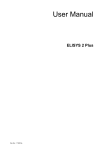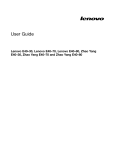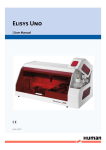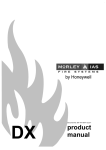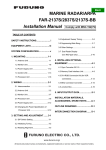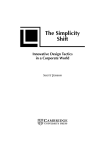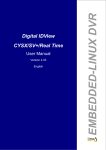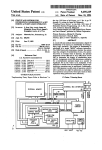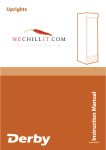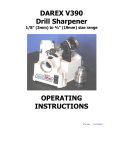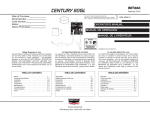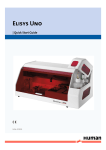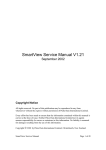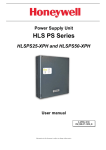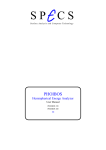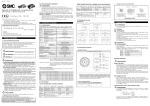Download User Manual - Frank`s Hospital Workshop
Transcript
User Manual
!"#$%$&'
Cat.-No.: 17300/1
!
(!)#$#*+&"#$,&*-&,.!&/0+10"
No.
DATE / Rev. REVISION DESCRIPTION
0
990614
Preliminary issue
1
000727
NEW: Block- and Group-Definitions
2
000915
NEW: Spare Parts, Page 55
NEW: Rack definition, Page 56
3
000921
NEW: External Incubation, Page 45;
NEW: Single step operations, Page 30
4
000925
CHANGE: Maintenance, Page 46
NEW: Change syringe tip, Page 48
CHANGE: Decontamination procedure, Page 47
5
020423
NEW: Software Version 3.28
CHANGE : Spare Parts- Consumables, Page 68
6
030217
NEW: Integration of new ELISA Tests
CHANGE: Updated rack description
User Manual ELISYS 2 Rev. 6
1/75
,234&4356&7689&:7;<=
2/75
User Manual ELISYS 2 Rev. 6
>*+,!+,$
INTRODUCTION
0.1. Description
0.2. User Warranty
SECTION 1
GENERAL SAFETY WARNINGS
1.1. Danger-Warning Symbols
1.2. Intended Use of the Instrument
1.3. Use of the Instrument
SECTION 2
GENERAL INFORMATION
2.1. Instrument Description: Purpose and Features
2.2. Manufacturer’s Identification Label
2.3. Instrument Description
2.4. Instrument Measuring Principle
SECTION 3
INSTRUMENT TECHNICAL DATA
3.1. Main Features
3.2. Instrument Technical Specifications (*)
SECTION 4
INSTALLATION AND START-UP INSTRUCTIONS
4.1. Unpacking
4.2. Placing the Instrument
4.3. Power Supply
4.4. Wash And Waste Container Installation
4.5. Work Area
4.5.1
Samples Tray
4.5.2. Trays for Reagents and Controls
4.5.3. Pre-dilution Plate
4.5.4. Microplate
4.5.5. Wash Basin for the Needle
4.5.6. Reader – Washer Group
4.6. Elisys 2 - PC Connection
4.7. Software Installation on PC
4.7.1. PC Minimum Requirements
4.7.2. Software Installation
SECTION 5
OPERATING INSTRUCTIONS
5.1. Introduction
5.1.1. Operating Overview
5.1.2. Powering the Instrument
5.1.3. PC program starting
5.1.4. Operating Menu
5.2. Work Session Setup
5.2.1. Select Profile
5.2.2. Set Parameters
5.2.3. Sample Setting
5.2.4. Single Step Operation
5.2.5. Entering the Patient Card
5.3. Run Analysis
5.3.1. Run the Process
5.3.2. Work Area Preparation
5.3.3. Analysis Execution (Running Phase)
5.3.4. Displaying the Results and their Acceptance Evaluation
5.3.5. Patient Reports
5.4. Databases
5.4.1. Medical reports
5.4.2. Patient Cards
5.4.3. Notes
5.4.4. Assays
User Manual ELISYS 2 Rev. 6
5
5
5
7
7
7
7
8
9
9
9
9
10
11
12
12
12
13
15
15
15
16
16
17
18
19
19
19
19
19
19
20
20
20
20
21
21
21
21
22
22
22
24
25
26
27
28
31
32
33
33
34
35
36
37
37
38
39
39
3/75
5.5
Assay Parameter Setup
5.5.1
Working Parameters
5.6
Rack Arrangements
5.6.1
Disposition on the Working Area- Standard Racks
5.6.2
Disposition on the Working Area -Universal Racks
5.6.3
Disposition on the Working Area - Mixed Arrangement
5.6.4
Working with two Substrates
5.6.5. Definitions for BLOCK-, RACK TYPE- AND GROUP PARAMETER
5.7. Settings
5.7.1
Break on error
5.7.2
External Incubation
5.7.3
Simulation mode
5.7.4
92 Positions for predilution
5.7.5
Substrate incubation at 37°
5.7.6
Dilution and wash buffer names
5.8 Commands
SECTION 6
MAINTENANCE
6.1. Checks and Preventive Maintenance
6.2
Cleaning the Instrument’s Parts
6.3
Tubing, Diluter and Manifold Decontamination
6.4
General Inspections and Checks
6.5
Replace the Syringe Tip
SECTION 7
PUTTING THE INSTRUMENT OUT OF SERVICE
7.1. General Warnings
7.2. Put the Instrument out of Service
7.2.1. Momentary Stocking
7.3. Instrument Transport and Handling
7.4. Instrument Storage
APPENDIX A
INSTRUMENT DECONTAMINATION
Decontamination Procedure
Decontamination Declaration
APPENDIX B
Spare Parts – Consumables – Accessory Parts
APPENDIX C
ELISYS 2 Rack Description
APPENDIX D
Group – Rack-Block -Division
APPENDIX E
Definitions for Groups
Group No.1
Group No.2
Group No.3
Group No.5
Group No.20
Group No.131
APPENDIX F
On Line Module
APPENDIX G
Operating Flow Diagramm
4/75
40
47
53
53
54
54
55
55
56
56
56
57
58
58
58
59
60
60
60
61
61
61
62
63
63
63
63
63
64
64
65
65
65
66
67
67
68
68
69
69
70
70
70
70
71
71
72
72
73
73
75
75
User Manual ELISYS 2 Rev. 6
#+,(*?1>,#*+
@ABA ?64CD3E93F<
The purpose of the automated microplates analyzer ELISYS 2 is to analyse samples on microplates; it
has been specifically conceived to automatically process up to 2 plates on line.
This manual provides the operator with all the necessary instructions for a safety, suitable use as well as
the instrument maintenance recommendations.
Manual content:
G&
3<9DF5HC93F<&- warranty information and the CE conformity declaration
G&
46C93F<&B&G&general safety-warnings;
G&
46C93F<&'&G&general information such as the producer data, instrument description;
G&
46C93F<&I&G&instrument performances, technical data;
G&
46C93F<&J&G&installation and start up;
G&
46C93F<&K&G&operating instructions;
G&
46C93F<&L&G&the user’s periodic maintenance and checking and the repair policy;
G&
46C93F<&M&- how to put the instrument out of service, packaging, transport instructions;
G&
46C93F<&N&– Appendices including instrument decontamination and spare parts list .
This manual is considered as a part of the instrument; it has to be at the operator’s hand as well as at
the maintenance operator’s availability.
For accurate installation, use and maintenance, please read the following instructions carefully.
In order to avoid instrument or personal damages, carefully read the ”GENERAL SAFETY WARNINGS”
Section 1, describing the suitable operating procedures.
In case of breakdowns or any troubles with the instrument, apply to the local Technical Service.
@A'A
146D&O;DD;<9P
HUMAN warrants that instruments sold by one of its authorised representatives shall be free of any
defect in material or workmanship, provided that this warranty shall apply only to defects which become
apparent within one year from the date of delivery of the new instrument to the purchaser.
The HUMAN representative shall replace or repair any defective item at no charge, except for
transportation expenses to the point of repair.
This warranty excludes the HUMAN representative from liability to replace any item considered as
expendable in the course of normal usage, e.g.: lamps, valves, syringes, glassware, fuses, diskettes,
tubing etc.
The HUMAN representative shall be relieved of any liability under this warranty if the product is not used
in accordance with the manufacturer's instructions, not regularly maintained, used with equipment not
approved by HUMAN or used for purposes for which it was not designed.
HUMAN shall be relieved of any obligation under this warranty, unless a completed installation /
warranty registration form is received by HUMAN within 15 days of installation of this product.
This warranty does not apply to damages incurred in shipment of goods. Any damage so incurred shall be
reported to the freight carrier for settlement or claim.
User Manual ELISYS 2 Rev. 6
5/75
@AIA
>!&>*+-*(/#,%
?!>"0(0,#*+&*-&>*+-*(/#,%
The producer declares that the instrument:
!"#$%!#&'(%)*+$,-!#&(!.!-/0&+
123456
&-)7/7(8
%9:;<9=>;?43(<2?(@"%!.(A1B@(A4?19:C
*9>D(.2
EFGHH
conforms to the following EEC Directives, included the last modifications:
73/23/EEC regarding low voltage
89/336/EEC regarding Electromagnetic Compatibility
93/68/EEC regarding the CE marking
and that the below harmonized standard specifications have been applied:
Safety:
CEI EN 61010-1 (1994) / CEI 66-5 ” Safety requirement regarding electrical equipment for
measurement, control and laboratory use ”
Electromagnetic Compatibility:
Emission: EN 55011 (1989) (CEI 110-6)
Immunity: EN 50082-1 (1992) (CEI 110-8)
The General Manager
6/75
User Manual ELISYS 2 Rev. 6
$!>,#*+&B
Q!+!(0"&$0-!,%&O0(+#+Q$
BABA ?;<R6DGO;D<3<R&$PS:F74
In this manual the following symbols are to remind the user of the safety rules:
This is a symbol of generic DANGER. It means that serious dangers might occur to the operator if
the described precautions are not fulfilled.
This is a symbol of high electrical voltage; by touching parts reporting this label, life endanger
might occur. Parts reporting this label can be handled only by qualified operators after having
unplugged the power supply cable.
This symbol indicates that the instrument makes use of chemical reagents and other dangerous
(corrosive, irritant and harmful) CHEMICAL SUBSTANCES which can cause damages to people
and material. When this label is found, pay attention to the producer’s recommendations
This symbol indicates that the instrument involves the handling of samples which can be infected
(urine and human serum). In this condition INFECTIONS or CONTAMINATION might occur. Pay
attention to the general safety warnings when in presence of such biological substances. Use
protective clothes, gloves and glasses.
This symbol indicates that damages to the instrument and/or its incorrect results could occur if the
given warnings are not respected.
This symbol is to advise that the instrument or part of the manual which is particularly important
has to be consulted.
BA'A
#<96<565&146&F8&926&#<49DHS6<9
The instrument is intended to be used in the following working conditions:
! reading of medical substances as specified in the technical data;
! only use the chemical reagents and accessories supplied and/or mentioned in this manual;
! work at room temperature and humidity, according to the specified data;
! do not power the instrument in a potentially explosive environment or at risk of fire.
The instrument has to be used as described in this manual. Any other use has to be regarded as
improper.
User Manual ELISYS 2 Rev. 6
7/75
BAIA
146&F8&926&#<49DHS6<9
The instrument has to be used for the expected purposes and in perfect technical conditions, by qualified
personnel, in working conditions and maintenance operations as described in this manual, according to
the safety rules.
This manual contains instructions for qualified operators.
! TH;738365&146D has to make sure that environmental condition is suitable, the installation is correct,
the use and maintenance are proper, according to the general safety rules as well as to the
particular precautions described in the manual (although he is not entitled to repair the instrument).
! TH;738365& ,6C2<3C3;< is entitled to maintain and fix the instrument, according to the instructions
received and using the original spare parts.
0796D;93F<4& F8& 926& 3<49DHS6<9& ;D6& EDF23:3965A& ,26& H46D& 34& 73;:76& 8FD& ;<P& 3<49DHS6<9& 3SEDFE6D
SF5383C;93F<&;4&U677&;4&926&56D3V3<R&CF<46WH6<C64A
Should the instrument need extraordinary maintenance, ask for .HS;<&$6DV3C6&or for licensed service
centres. The maintenance will be carried out by Specialised Technicians that will be able to fix the
instrument using the original spare parts to replace the defective ones.
8/75
User Manual ELISYS 2 Rev. 6
$!>,#*+&'
Q!+!(0"&#+-*(/0,#*+
'ABA #<49DHS6<9&?64CD3E93F<X&YHDEF46&;<5&-6;9HD64
ELISYS 2 (fig.2.1) is an automated instrument designed to carry out tests on microplates by optical
density reading. It is able to mix organic samples (by pre-diluting them, if necessary) with reagents and
to process up to 2 plates on line.
fig. 2.1
'A'A
/;<H8;C9HD6DZ48<9383C;93F<&";:67
/;56&3<&!>
/;<H8;C9HD65&8FD&.1/0+
QS:.&Q6DS;<P
0YY0(AX
>;9AG&+F
User Manual ELISYS 2 Rev. 6
$!(#0"&+A
-0[(#>0,!?
9/75
'AIA
#<49DHS6<9&?64CD3E93F<
The instrument that is shown in figure 2.2 is composed of:
- Instrument framework and protection lid
- Control system run by electronic parts
- Aspirating and dispensing system
- Mechanical arm carrying a dispensing needle
- Movable photometer and plate washer
- Work area with: two microplate places, a washing basin, reagent trays, a tray for samples and two
predilution plates.
Protection lid
Arm
Photometer and
Plate washer
Needle
Work area
fig. 2.2 Front view (Lid lifted up)
10/75
User Manual ELISYS 2 Rev. 6
'AJA
#<49DHS6<9&/6;4HD3<R&YD3<C3E76
Below (fig. 2.3) is the diagram representing the main functional elements of the instrument photometric
section.
A monochromatic filtered beam of light produced by a lamp goes through the well containing the sample.
Part of the light is absorbed by the sample, the remaining one is detected by a photodiode. The
photodiode converts the received light in an electrical signal that is once again transformed into
frequency. By this frequency the microprocessor calculates the absorbance, taking in account of the
blank measure carried out at the beginning. The following is the formula to calculate the absorbance:
!"#$%&'$()*+,-$./0120,345$6$%&'$(7+89*0$./0120,345
B&&&"0/Y&
'&&&"!+$
I&&&?#0Y.(0Q/
1
J&&&O!""
K&&&#+,!(-!(!+,#0"&-#",!($
3
L&&Y.*,*?#*?!
2
4
2
5
2
6
8
channels
X
fig.2.3
User Manual ELISYS 2 Rev. 6
11/75
$!>,#*+&I
#+$,(1/!+,&,!>.+#>0" ?0,0
IABA
/;3<&-6;9HD64
).7#+"%&.#(!)%
ELISYS 2 is a fully automated analyzer able to carry out up to 8 tests on two microplates.
7!%,-&7
Max capacity 40 samples in 16 mm primary tubes or 60 samples in 10 mm primary tubes (optional).
Samples predilution on two 20 well plates, programmable for each assay.
+&!A&.#7
Modular trays for calibrators, controls, conjugate, chromogen, stop solution, reagents and sample
dilution.
+&!*#)$.(!+&!
Max location of 2 microplates with 96 wells each which can be incubated at programmable temperature.
')7,&.7!#)$.
An arm with three directions (x, y, z axis) carrying a level sensor dispensing needle.
In the aspiration phase, the sensitive needle stops at liquid meniscus level to reduce contamination.
I!7@).A
Needle: external surface by dipping it into the washing basin with flowing water;
internal surface by dispensing the washing solution in the washing basin discharge.
Plates: one 8-channel dispensing manifold, able to run two independent washing solutions
one 8-channel manifold to drain a row of wells at one time
$,#)*!-(7/7#&%
Reader: 8 photometric channels equipped with lenses, interferential filters and lamps.
Results: available at the end of the work session to be stored and printed.
&J#&+.!-(-)K")'(*$.#!).&+7
External containers are delivered with the instrument to contain washing solutions, dispensing solution
and the liquids waste (each container is equipped with a level switch),
7$L#I!+&
A PC software, run by WINDOWS ’95/’98, allows to:
!
set up the requested analysis and to process on line different methods
!
give to the instrument the relevant commands
!
receive and transfer the analysis result
!
print and file the results
!
memorise the calibration curves.
12/75
User Manual ELISYS 2 Rev. 6
IA'A&
#<49DHS6<9&,6C2<3C;7&$E6C383C;93F<4&\]^
PROCESS CAPABILITY
Combination up 8 assays on 2 microtiter plates on line
WORK AREA
Modular composition:
"
Microtiter plates
2 microplates with 96 wells (12 strips, each one with 8 wells)
"
Sample tray
one tray for 60 primary tube Ø10#12 x 100 mm, replaceable with a 40 primary tube
Ø14#16 x 100 mm tray
"
Common reagent trays different types (depending on the assay category), for substrate, stop solution,
cleaner, dilution solution bottles, common reagents
"
Specific reagent trays
different types (depending on the specific assay), for calibrators, controls, specific
reagents
"
Predilution plates
2 plates, each one with 20-wells
PREDILUTION
Programmable for each sample,
DISPENSATION
Three freedom degrees Arm (x, y, z axis) carrying the needle
DISPENSATION SYRINGE
"
Total volume
1000 µl
"
Minimum volume
10 µl
"
Accuracy
Better than 1% at a volume of 100 µl
PIPETTING SPEED
"
Samples
35 minutes for 96 wells for a washing volume of 1 ml
"
7 minutes for 96 wells for a washing volume of 1 ml
Reagents
CARRY OVER
Minimised to less than 3% by washing the pipetting system after each single
sample dispensing and after each reagent dispensation phase
LIQUID SENSORS
"
Sample dead volume
Sample and reagent levels are sensed by the needle used as a capacitive
sensor
Less than 150 µl
"
Reagent dead volume
Between 100 µl and 400 µl depending on the bottles used
MICROPLATES WASHING
8-channel moving manifold with separate filling and aspiration ports
2 different washing solution to choosing from within a work session
NEEDLE WASHING
External and internal washing
REAGENT WASTE
About 10% (*) of reagent aspirated for all the assays
(*) used for cleaning the sampling system
EXTERNAL TANKS
"
Wash buffer 1and 2
two 2-liter bottles
"
Wash solution
a 5-liter bottle
"
Waste
a 10-liter tank
Each one is equipped with a level switch to check whether the tank is full or empty
INCUBATION
At room temperature (Ta) or programmable from Ta+5°C up to 45 °C in steps of
1°C
PHOTOMETER
Moving 8 channel device with automatic blanking and internal calibration
"
Light source
Tungsten lamps
"
Filters
2 standard interferential filters: 450 and 630 nm, bandwidth 8 nm
"
Detectors
Silicon photodiodes
"
Measurement range
0.000 - 3.000 OD (Optical Density)
"
Accuracy
from 0.000 to 1.500 OD
from 1.500 to 3.000 OD
"
Stability (short term)
Other wavelength values on request .Two more optional filters to be added .
User Manual ELISYS 2 Rev. 6
$ 1% or $ 0.010 OD whichever the bigger
$ 2%
0.001 OD in 1 minute
13/75
:;<=>?@A;=$=ABC;:BD%$<EAB:F:BD=:!;<
(B&,GH,20I5
SERIAL INTERFACE
RS232
ELECTRICAL POWER REQUIREMENT
Standard 220 or 110 Vac 50/60 Hz
POWER CONSUMPTION
500 W Max
OPERATING CONDITIONS
Temperature
from +15°C to +30°C
Relative Humidity
up to 80%
SHELF CONDITIONS
Temperature
from "10°C up to +60 °C
Relative Humidity
up to 85%
DIMENSIONS
"
Width
790 mm
"
Height
595 mm (980 mm with lifted up lid)
"
Depth
600 mm ( 650 mm with lifted up lid)
"
Instrument
72 Kg
"
Packed instrument
97 Kg (wooden box dimensions: 89x68x75 cm)
WEIGHT
EUROPEAN REFERENCE DIRECTIVES
HARMONIZED
SPECIFICATIONS
STANDARD
INSTRUMENT OUTFIT
PC (optional supply)
"
"
"
73/23/EEC regarding low voltage electrical material
89/336/EEC regarding Electromagnetic Compatibility
93/68/EEC regarding the CE mark
Safety:
EN 61010-1 (1994) / CEI 66-5 ”Safety requirements for measurement
electrical equipment checking and laboratory use”
Electromagnetic Compatibility:
Emission: EN 55011 (1989) (CEI 110-6)
Immunity: EN 50082-1 (1992) (CEI 110-8)
The instrument is equipped with:
! User’s manual
! Mains power cable.
! Modular reagents trays (kit)
! Two predilution plates
! A tray for 40 samples
! Two 2-liter bottles for wash buffer 1and 2.
! A 5-liter bottle for wash solution.
! A 10-liter waste tank
! RS232 PC connection cable
! Software for PC to master the instrument
! (On request: BDE Installer for Microsoft Windows 98 II.Edition)
The PC minimum requirements are:
! Microsoft Windows 95 or 98 (for Microsoft Windows 98 II.Edition you
need the BDE-Installer version 1.0)
! 15 MB free on hard disk
! 1.44Mb floppy driver
! RAM 32 Mb
! Pentium or compatible processor at 166 MHz
! Display adapter standard VGA 640x480
! Printer
(*) The described features can be altered at the producer’s discretion without forewarning.
14/75
User Manual ELISYS 2 Rev. 6
$!>,#*+&J
#+$,0""0,#*+&0+?&$,0(,G1Y&#+$,(1>,#*+$
#<49;773<R&;<5&46993<R&HE&926&3<49DHS6<9_&926&4;869P&U;D<3<R4& ;<5& R6<6D;7& DH764& 564CD3:65&3<& $6C93F<& B
SH49&:6&F:46DV65A
O;D<3<R`&&U26<&SFV3<R&FD&73893<R&926&3<49DHS6<9&CF<4356D&X
JABA
!
#+$,(1/!+,&O!#Q.,&%
%&N@&aR
!
Y0>a!?&#+$,(1/!+,&O!#Q.,&%
%&B@@&aR
1<E;C=3<R
The instrument is packed with a plywood box, which can be easily moved by a lifting trolley.
Be careful when placing the instrument onto the work area.
To unpack the instrument follow the instructions as below described:
" Remove the packaging band around the plywood box.
" Lift the plywood box straight up from the bottom plate and place it beside the instrument.
" Remove the packaging band and the protective plastic sheets around the instrument.
" Unscrew the four 10 MA screws fixing the instrument body to the bottom plate of the box.
" Save the empty box and the fixing screws for future transportation.
If the instrument was already in use check for the ?!>*+,0/#+0,#*+& ?!>"0(0,#*+ (see Appendix A of this
manual).
Y"!0$!&$0)!&,.!&!/Y,%&[*b&` This box is designed and manufactured for this instrument only and should be
used in future transportation.
User Manual ELISYS 2 Rev. 6
15/75
JA'A
Y7;C3<R&926&#<49DHS6<9
The instrument has to be placed on a levelled bench, assuring enough free space around the instrument
to allow maintenance operations (35 # 50 cm on the rear and on the lateral sides).
Room temperature has to be between 10 and 30 °C with relative humidity below 80%; protect it from
direct sunshine.
JAIA
YFU6D&$HEE7P
Once the instrument and its outfit have been placed, plug it to the right power source using the supplied
cable.
fig.4.1
O;D<3<RX&S;=6&4HD6&92;9&926&676C9D3C;7&EFU6D&4FHDC6&34&926&F<6&;4&D6WH64965&;<5&3<53C;965&F<&926
7;:67&:64356&926&3<49DHS6<9&EFU6D&4FC=69&`
c&&''@&)d&&FD&&BB@&)d&e
O;D<3<RX& S;=6& 4HD6& 92;9& 926& 8H464& V;7H6& CFDD64EF<54& 9F& 926& F<6& 3<53C;965& :64356& 926& 8H46
2F756D`
&&'&&WH3C=&8H464&IAK&0
''@&);C&S;3<4&&&&
&&'&&WH3C=&8H464&&&M&0
BB@&);C&S;3<4&&&&&
16/75
User Manual ELISYS 2 Rev. 6
JAJA
O;42&0<5&O;496&>F<9;3<6D&#<49;77;93F<
In figure 4.2 are shown the washing/discharging containers and their connections with the instrument.
Blank
0
Red
$
[
WASTE
WASTE
RS 232
LEVEL CONTROL
(
Wash
Wash
buffer 1 buffer 2
Red
Blank
O;42
:H886D&
&&&&B
O0$.
,I
O;42
:H886D&
&&&&'
,B
O0$,!
,'
$
Precision Syringe
0
Peristaltic Pump for needle external washing
[
Peristaltic Pump for Microplate washer
,B
O;42&:H886D&BX bottle for the microplates washing solution (see note 1).
,'
O;42&:H886D&'X bottle for the microplates washing solution.
,I
O;42: bottle for the needle external washing solution (see note 1).
,J
O;496X&tank to collect the waste.
(
Level control connector
,J
fig. 4.2
User Manual ELISYS 2 Rev. 6
17/75
Before switching on the instrument:
" fill up the T1, T2, T3, bottles with the right solution according to the method requirement
" place the T4 empty container (waste)
" connect the tubing to their relevant container as shown in figure 4.2.
" make sure that the tubing are properly connected and that they are in good condition.
" plug the lead of the level sensor to the instrument socket (connector R).
;&G0$J$K$DG$GL0$0,I$&.$+$M&/-$7077H&,N$&/$.&/$73L0I2*0I$8+H,G0,+,30N$GL0$H,7G/280,G$/012H/07$+$M+7LH,'$343*0O$:,$GLH7$3+70
P
JAKA
"
)&GG*0$=J$L+7$G&$ )0$72)7GHG2G0I$MHGL$ +,$012HQ+*0,G$)&GG*0$3&,G+H,H,'$IH7GH**0I$M+G0/$ &/$I03&,G+8H,+GH,'$7&*2GH&,$.&/
8+,H.&*I$3*0+,H,'$(700$<03GO$R5O
"
)&GG*0$=S$L+7$G&$)0$72)7GHG2G0I$MHGL$+,$012HQ+*0,G$)&GG*0$3&,G+H,H,'$I03&,G+8H,+GH,'$7&*2GH&,$.&/$,00I*0$H,G0/,+*$+,I
0TG0/,+*$3*0+,H,'$(700$<03GO$R5O
OFD=&0D6;
Figure 4.3-a and fig.4.3-b show a typical work area layout.
R e a d e r/ W a sh e r
G ro u p
N e e d le
W a s h in g
b a s in
M ic ro p la te s
1 11 21 31
2
3
4
5
6
7
8
9
10
S a m p le s
tra y
D i lu t i o n
s o lu t i o n
b o t t le s
S u b s t r a te
S t o p s o l u t io n
C le a n e r
R e a g e n ts
tra y s
fig. 4.3 - a
fig. 4.3 - b
18/75
User Manual ELISYS 2 Rev. 6
JAKAB
$;SE764&,D;P
JAKA'A
The sample tray is a support for sample vials (primary tubes) to be analysed.
The tray may be for 60 primary tubes sized 10#12 mm in diameter and 100 mm in height (optional) , or
40 primary tubes sized 14#16 mm in diameter and 100 mm in height.
Vials are manually loaded, according to the program instructions (see paragraph 5.3).
,D;P4&8FD&(6;R6<94&;<5&>F<9DF74
JAKAIA
Different types of reagent trays may contain dilution solutions, substrate, stopping solution, cleaner,
conjugate, calibrators and controls. Part of them are common for all the assay methods of the session,
wile other trays contain the reagents for the specific assay methods.
The reagent vials have to be placed on particular positions as shown as typical example in fig. 4.3-a and
according to the given program instructions (see paragraph 5.3) for the specific assay method.
YD6G537H93F<&Y7;96
The pre-dilution plate is a molded 20 wells plastic container. The needle dispenses the sample along
with dilution solution into each cup according to the running program.
There are two pre-dilution plates, so that a total of 40 pre-dilution cups are available.
JAKAJA
The program advises to locate the pre-dilution plates before starting the process (see paragraph 5.3).
/3CDFE7;96
The microplate is a support for 96
reaction wells. One or two microplates
have to be located on their relevant
places.
The washer and the photometer are able
to run through the plate in order to read
and wash the related wells.
Each microplate can host up to 12 strips,
each strip containing 8 wells.
The PC program advises to locate the
microplates before the start of the
running process (see paragraph 5.3).
fig.4.3 -b
I9?:M:N6(>2(O?4P4:>(M:Q>?;14:>(>?2;B54Q(3;?M:N(1M=?2O59>4(R9QSM:N(Q4T;4:=4U(955(>S4(?4T;4Q>43(Q>?MOQ(1;Q>
B4(=21O54>43(RM>S(>S4(V(R455Q(W
JAKAKA
O;42&[;43<&8FD&926&+66576
In order to wash the external part of the dispensing needle, it is dipped into the wash basin where the
washing liquid continuously flows. To wash the internal part of the needle the dispensation liquid is
pumped into it.
JAKALA
To prevent samples contamination, the needle washing system is automatically activated, when
necessary.
(6;56D&f&O;426D&QDFHE
The reader–washer group is located on the top of the microplates area. It allows to run automatically
both the photometric reading and the microplates washing, in succession according to the program.
User Manual ELISYS 2 Rev. 6
19/75
JALA
!734P4&'&G&Y>&>F<<6C93F<
The instrument is equipped with an RS232 serial port for PC connection.
A 9-pin connector is available on the instrument right side panel (see fig. 4.4).
Generally two serial ports to choose from are located on the rear panel of a PC: COM1 and COM2, a 9pin male connector and/or a 25-pin male connector.
A connection cable PC- ELISYS 2 with two 9 pin connectors (female- male) is supplied with the
instrument. An adapter 9-25 pin may be necessary on the PC side connection.
2
3
4
5
7
5 4 3 2
7
Tx
Rx
DTR
GND
RTS
Fig. 4.4 RS232 serial port located at the instrument right side
JAMA
$F89U;D6&#<49;77;93F<&F<&Y>
JAMABA
Y>&/3<3SHS&(6WH3D6S6<94
"
Microsoft Windows 95 or 98
"
15 MB free on hard disk
"
1.44 Mb floppy driver
"
RAM 32 Mb
"
Pentium or compatible processor at 166 MHz
"
Display adapter standard VGA 640x480
Printer .
$F89U;D6&#<49;77;93F<
"
JAMA'A
AP 2 is the program specifically developed for ELISYS 2.
To install AP 2 program on the PC place ELISYS 2 CD in the CD-ROM drive. If the installation program
does not start automatically, proceed as follows:
"
Start Explorer from the Start menu and select the letter of the CD drive.
"
Start the $69HEA6g6 program by double clicking with the left key on the mouse.
The installation program is now initialised. Follow the instructions shown on the screen.
The program is now installed and the ELISYS 2 icon is available on the desktop. Double click on it to run
the program.
+419?X6(L2?(%M=?2Q2<>(IM:32RQ(YV())D&3M>M2:(C2;(:443(>S4(Z'&[):Q>9554?(P4?QM2:(EDH
\(Q>9?>(Z'&[):Q>9554?(95Q2(RM>S(74>;OD4]4^D
20/75
User Manual ELISYS 2 Rev. 6
$!>,#*+&K
*Y!(0,#+Q&#+$,(1>,#*+$
KABA #<9DF5HC93F<
The instrument requires the use of chemical reagents and other dangerous (corrosive, irritant and harmful)
CHEMICAL SUBSTANCES which can cause damages. When this label is found, be careful and pay attention
to the producer recommendations
The instrument requires to handle samples which can be infected (urine and human serum). In this condition
INFECTIONS or CONTAMINATION might occur. Pay attention to the general safety warnings as to the
presence of such biological substances. Use protective clothes, gloves and glasses.
In particular:
!
Wear protective clothes and gloves.
!
At the end of a work Session, clean the work panel and its accessories carefully by using a cloth soaked
in a 0.5% sodium hypochlorite solution.
!
Waste material produced by the analytical and cleaning process is a dangerous material which might
contaminate people and material. Get rid of the waste material according to the local regulations.
KABABA
*E6D;93<R&*V6DV36U
Table 5.1 shows the general operating sequence.
P C s w itch in g o n
an d p ro g ra m s ta rt
W O R K S E S S IO N
W o rk s e s s io n
se tu p
R u n A n a ly s is
S ta rt w o rk s e s s io n
or
o t h e r fu n c t io n s ?
O T H E R F U N C T IO N S
P a r. 5.2
P a r. 5.4
D a ta ba s e s
P a r. 5.5
S e ttin g s
P a r. 5.6
Com mands
P a r. 5.7
H e lp
P a r. 5.3
,;:76&KAB&f&Q6<6D;7&FE6D;93<R&87FU&53;RD;S
User Manual ELISYS 2 Rev. 6
21/75
KABA'A
YFU6D3<R&926&#<49DHS6<9
Switch on the instrument (the switch is located on the right side).
On the front side of the instrument there are three coloured lamps as below specified:
Y*O!(
green lamp
indicating that the instrument is switched on
(1+
yellow lamp
indicating that the instrument is in running phase
!((*(
red lamp
indicating that no liquid is inside some container of the work panel
(;&G0$J)
;&G0$JP$=L0$8+3LH,0$M&,UG$7G&9N$)2G$GL0$IH79*+4$7L&M7$GL0$Q&HI$9&7HGH&,7O
KABAIA
Y>&EDFRD;S&49;D93<R
The ELISYS 2 icon is available on the desktop. Double click on it to run the program.
The main menu will appear:
KABAJA
*E6D;93<R&/6<H
Tables 5.2 and 5.2a show the instrument operating menus and their function.
/6<H&8H<C93F<&6gE7;<;93F<
22/75
User Manual ELISYS 2 Rev. 6
$6443F<
New
To start a new work session.
Modify
To modify the setting of the last loaded session, if processed or not. If no
session has been programmed, it assumes the New function as the previous
paragraph.
Show lab results
Display of existing Labfiles
Lab Printing
To print all the information concerning each analysis session already
processed, values for the samples, controls and standards, as well as any
mistake if any.
Printer Set-up
To set up the printer
Single Steps
Activates the single steps operation
Run
This command runs the working procedure, if a session has been set up.
Last
display
results
Exit
Activates the display of the results of a processed but not stored working
session.
Exit from the program.
?;9;:;464
Medical report
Displays the stored medical reports. They can be accessed or by the
patient's name and/or the execution session date.
Patient card
To display, modify and insert the patients in the database.
Notes
To display, modify and insert the sentences frequently used and associated
to the notes in the report.
Assays
To display, modify and insert the parameters for each method.
$6993<R4
Lab name
To set the heading to be printed on the lab printing reports.
Doctor’s name
To indicate the doctor's name on the analysis report.
Serial port
To choose the serial port or simulation mode
Password
To insert or modify the password.
Ext. incubation
Enables the external incubation function.
>FSS;<54
Needle prime
To prime the needle.
Washer prime
To prime the washer.
Micro-plate
washing
To set the number of strips to be washed.
Micro-plate
aspiration
To set the number of strips to be emptied.
Temperature test
To set the reference temperature and to monitor it continuously.
Movements test
To check the instrument's moving parts and show any bad functioning.
.67E
About….
To display all the information concerning that software version.
Software
To display the software interactive guide.
User Manual ELISYS 2 Rev. 6
23/75
KA'A&
OFD=&$6443F<&$69HE
From the <077H&, menu, click on ;0M$to access the E/&.H*07$ <0*03GH&, window which shows the blank
fields.
Remark: B*H3-H,'$&,$V;0MV$GL0$808&/4$3&,G0,G7$&.$GL0$+99*H3+GH&,$+/0$/070G$+,I$GL0$9/0QH&27$/072*G7$ +,I$ 70G$297
+/0$*&7GO
From the <077H&, menu, click on @&IH.4 to access the Profiles Selection window. The stored setting up
of the previous working session can be modified.
START
SE S S ION
Mo d if y
New
$!"!>,
Y(*-#"!
S E L E C T P R O F IL E
Par. 5.2.1
OK
$!,
Y0(0/!,!($
SET PARAMETERS
Par. 5.2.2
$0/Y"!
$!,,#+Q
CALIBRATION CURVE
(for Quantitative assays only)
page 1/4
SAMPLE SETTING
PATIENT CARD
Par. 5.2.3.1
Par. 5.2.3
OK
PATIENT DATABASE
RUN ANALYSIS
Par. 5 .3
,;:76&KAI&f&$6443F<&469GHE
24/75
User Manual ELISYS 2 Rev. 6
KA'ABA
$676C9&YDF8376
A profile is a set of assay methods (maximum 8) to be processed at the mean time with the same set of
samples.
To recall a message memorised previously, it can be selected in the <0*03G$9/&.H*0 list on the left side of
the window..
By clicking on the "0*0G0$E/&.H*0$button, it is possible to erase a profile memorised previously.
Use panel <+89*0$/+3- to choose between operating with a 40 samples or a 60 samples rack.
Once the Assays have been set, press OK to save the profile. This is very useful, when the same type of
analysis is run frequently.
Note: Not all of the methods are necessarily compatible amongst themselves. That means, that it isn't
possible to execute methods which present different characteristics in the same session.
E.g., it is not possible to process different sets of methods at the same time, in the following situations:
"
more than two washing solutions,
"
more than two dilution liquids,
"
different incubation temperatures,
"
different conjugate or substrate incubation times
"
The program signalises these incompatibilities and
doesn't allow to continue the setting up of a session as
long as the operation hasn't been cancelled, or until
the incompatibilities have not been removed.
At the end, the program enables to change the sequence of the set methods, in order to:
reduce the execution time of the session,
"
reduce the number of changes of the washing solution,
"
minimise (reduce at a minimum) the solution quantity necessary to prime.
"
In those cases the following message appears
to the user, confirming the change.
User Manual ELISYS 2 Rev. 6
25/75
KA'A'A
$69&Y;D;S696D4
After clicking !W, for confirmation of each method set in the previous window (<0*03G$9/&.H*05N the window
<0G$9+/+80G0/7 appears (page 1/n ).
For each method, it is possible to set the following (,&G0 J):
"
the repetition of the blanks, controls, samples e of the calibrators, if the execution modality foresees
a quantitative analysis,
"
the execution modality (qualitative or quantitative (,&G0$X5),
"
the reagents lot and its expiry,
"
the Cut-off factor (,&G0$S),
"
when to use the controls (at the beginning, at the end, every N samples).
Clicking Next or OK you go on to the next assay method (page 2/n).
;&G0$JP$=L0$9/&'/+8$7G&/07$*+G07G$70*03G0I$&9GH&,7$&.$GL0$/01207G0I$80GL&I$+,I$IH79*+47$GL08$+2G&8+GH3+**4O$:,$+,4
3+70$HG$H7$9&77H)*0$G&$8&IH.4$GL08O
;&G0$X$P$=L0$9/&'/+8$&,*4$+**&M7$GL0$0T032GH&,$&.$GL0$12+,GHG+GHQ0$0Q+*2+GH&,$80GL&I$H.$GL0$3&//079&,IH,'$I+G+$L+Q0
)00,$70GO
;&G0$SP$*;>($<<(<9=>2? fieldO
F&/$8&7G$&.$GL0$80GL&I7$0T032G0I$H,$12+*HG+GHQ0$0Q+*2+GH&,$HG$H7$,03077+/4$G&$*0+Q0$GLH7$Q+*20$.HT$&,$JO
=L0/0$+/0$IH..0/0,G$80GL&I7$3+**0I$708HK12+,GHG+GHQ0$0Q+*2+GH&,$MLH3L$270$&,*4$&,0$-,&M,$3&,30,G/+GH&,$3+*H)/+G&/O
:,$GLH7$3+70$GL0$7+89*0$3&,30,G/+GH&,$H7$3+*32*+G0I$+7$.&**&M7P
7+89*0$!"$Y$3+*H)/+G&/$!"$Z$3+*H)/+G&/$3&,30,G/+GH&,
=&$0T032G0$GLH7$3+*32*+GH&,$GL0$3+*H)/+G&/$3&,30,G/+GH&,$L+7$G&$)0$70G$H,$GL0$B?=K!FF$FDB=!>$.H0*IO
26/75
User Manual ELISYS 2 Rev. 6
>;73:D;93F<&CHDV6
The last calculated curve is displayed
in quantitative methods if there are
already previous calibration values.
The curve plotting is specific for each
method.
In any case it is possible to:
"
change the axes scale
"
decide to evaluate the samples
based on memorised values (keep
them) or proceed to a new curve
calibration (execute new).
KA'AIA
$;SE76&$6993<R
After the setting of the parameters of each method, the window shown allows to couple the samples with
the methods.
This window allows in fact to associate every sample to be analysed with one or more methods present
in the selected profile.
Selecting any B&I0 field of the window it is possible to use the <0*.KH,3/0+70 key to set a predefined
patient code. Further clicks on that button will add a different progressive code for the following patient.
They keys on the right and the left of the page number allow to show following or previous sample
positions.
By means of the arrow on the right side of the patient code, you chose that sample for all the analysis.
Analogously, using the arrow under the method name, all the samples appearing on the page are
chosen for this type of analysis.
It is possible to select one by one the coupling of the sample and the method, by clicking on the box at
the centre of the window.
The current number of the used wells is shown under each column related to the method.
At the bottom of the window there are two fill-up indicators. The first one is referred to the presently
occupied strips, the second one to the necessary time for the dispensing of the samples, controls and
calibrators for the session. (;&G0$J5
User Manual ELISYS 2 Rev. 6
27/75
;&G0$JP$=L0 7077H&,$H7$+2G&8+GH3+**4$IHQHI0I$H,$Q+/H&27$/2,7$H.$GL0$G&G+*$7+89*0$IH790,7+GH&,$GH80$H7$*&,'0/$GL+,
GL0$7+89*0$H,32)+GH&,$GH80$&.$GL0$.H/7G$80GL&IO
The program advises the user and disables the selection if the maximum of the pre-dilution cups (40) or
the strips (24) is reached.
Clicking on !W the session is memorised with the actual settings.
Clicking on >2, the working session begins to run (;&G0$X).
[ See Par. 5.3 ]
KA'AJA& $3<R76&$96E&*E6D;93F<
To run an assay in a sequence of distinct phases, or just a specific phase, select <H,'*0$7G097 under the
item <077H&, of the main menu.
A window will appear for the assay set-up, similar to that of par. 3.2.3, but with three additional buttons to
allow the selection of the desired phases in single steps.
In this mode of operation, after each phase (steps), the machine stops, waiting the command to go on to
the following phase ( step).
28/75
User Manual ELISYS 2 Rev. 6
'MQO4:Q4
1
Samples predilutions
(0h 16’ 53’’)
2
Samples and controls
(0h 44’ 47’’)
3
Conjugate(s)
(0h 12’ 37’’)
4
Substrate(s)
(0h 12’ 39’’)
5
Stop solution(s)
(0h 12’ 32’’)
Pressing this button the following menu appears:
Selecting this item, the machine will execute the sample
predilution, in accordance the selected assay settings.
Selecting this item, the machine will execute the
dispensation of the samples and controls, in accordance to
the selected assay settings.
Selecting this item, the machine will execute the
dispensation of the conjugate in accordance to the selected
assay settings.
Selecting this item, the machine will execute the
dispensation of the substrate in accordance to the selected
assay settings.
Selecting this item, the machine will execute the
dispensation of the Stop solution in accordance to the
selected assay settings.
Note1: In phases 1, 2, 3 the machine does not consider the incubation times programmed for that assay.
For this reason the operator shell apply directly the necessary incubation time for each, using a
stop watch or a timer.
Note2: The timer indicated for each phase is the expected duration of that phase.
User Manual ELISYS 2 Rev. 6
29/75
I9QS
1
Pressing this button the following menu appears
Activate microplate(s)
Selecting this item, the machine will execute the
activation of the microplate(s), respecting the
previously set time
(0h 0’ 0’’)
2
Wash sample and control wells
(0h 15’ 24’’)
3
Wash conjugate wells
(0h 12’ 39’’)
+493
1
Read microplate(s)
(0h 15’ 10’’)
30/75
Selecting this item, the machine will execute the
first washing cycle respecting the previously set
time.
Selecting this item, the machine will execute the
second washing cycle respecting the previously set
time
Pressing this button the following menu appears:
Selecting this item, the machine will execute all the reading
and will show all the result, with the possibility to print the
laboratory file and the results.
User Manual ELISYS 2 Rev. 6
KA'AKA& !<96D3<R&926&Y;936<9&>;D5
It is possible to couple each sample
to a patient report, selecting the
B&I0 field in the window and
clicking on the E+GH0,G$3+/I$button.
In the window which appears,
information regarding the patient
and the sample can be inserted.
To accept the information given, the
following boxes must at least be
filled in: E+GH0,G6:"N$ [/&29N$ ;+80N
\H/GL$I+4N$<+89*0$I+G0$0$=H80O
Patient's information already stored in the
database, can be accessed by clicking on
the "+G+\+70 button and by selecting the
patient's name amongst the ones present in
the file.
The card can also be filled in and the
information registered in the database. This allows to memorise the
information of patients which have to
be checked often.
In this case the program asks which
operation to carry out.
More information about the patient
chosen can be inserted by using the
button @&/0$;&G07O
There can be inserted up to 5
additional comments.
In this case the "+G+\+70 button can
also be used, proceeding equally as
explained previously.
User Manual ELISYS 2 Rev. 6
31/75
KAIA&
(H<&0<;7P434
START
RU N
5.
4.
3.a / 3.b
1.
Microplate comp ositi on
- to loc ate micr oplate s into th eir ow n loc atio ns
2.
Com mon reag ents
- to locat e rea gents on the reag ent s tray s
3.a Specific reagen ts for as say A - to locat e controls and ca lib rators assay A
2.
1.
O*( a&0(!0 &
Y( !Y0(0 ,#*+
WORK AREA
PREPARATION
3.b Specific reagen ts for as say B - to locat e controls and ca lib rators assay B
----4. Sa mple sera
- to locat e the samples int o the tray
next
Par. 5.3.2
5.
Start analysis
?
Dilution cu ps / Prime
- to locat e the pre diluti on plates
Don't forget to:
- locate t he washing solution bottle *
- locate t he wash buf fer1/ buff er2 bottles *
- locate t he waste tank **
* make s ure they have been filled
** make sure it is empty
NO
YES
=+,-$ *0Q0*$3& ,G/&*7
E/H80 $0T032GH&,
0+0"%$#$&
!b!> 1,#*+
Time flo w fo r every o pera tion
Par. 5.3.3
A N A LY S I S E X E C U TI O N
Sess ion-end rema ining tim e
Error s in process (liq uid not found)
D
D
C
C
A cou ple of w indows
(A-A, B-B, C- C, etc.)
for each ass ay
is prese nted
B
B
A
A
BLANK + STANDARD VALUES
CONTROLS
next
previous
?#$Y"0 %&h&!)0"10,!
(!$1",$
Par. 5.3.4
CALIBRATION CURVE
(for quantit ative analysis only )
ACCEPT
Accep t o r R eject
?
STORE RESULTS
REJECT
REJECT RESULTS
0>>!Y,&h&(!i!>,
(!$1",$
Par. 5.3.4
Go to the next assay
Last assay
?
NO
YES
LAB PRINT
04
03
02
01
PATIENT 01 REPORT
pre vious
next
PATIENT REPORT PRINT
Y0 ,#!+ ,
&(!Y*( ,$
Par. 5.3.5
OK
Go back t o the
MAIN MENU
Pa r. 5.1
,;:76&KAJ&f&(H<&;44;P4&46WH6<C6
32/75
User Manual ELISYS 2 Rev. 6
KAIABA
(H<&926&YDFC644
From the (H<&button&of the patient selection window during the setting of the session, or from the RUN
voice of the menu Session, it is possible to start the execution of the working session.
KAIA'A& &OFD=&0D6;&YD6E;D;93F<
_DGD8DED(%M=?2O59>4(=21O2QM>M2:
The first window shown is a summary of the
set methods and an overview of the
composition of the microplates.
It shows the strips used for each method and
in which execution they are carried out.
Prior the test performance the strips always
have to be filled up. It must be guaranteed
that all positions for each strip are occupied
with wells. Otherwise during the wash
process water will spill inside the instrument.
These positions are marked as neutral wells.
_DGD8D8D(*2112:(?49N4:>Q
The next window shows the display of the
common tray where the necessary dilutors,
wash solutions, stop-solution and substrate
must be arranged for all the methods to be
processed in the session.
;&G0P$"H..0/0,G$G/+47$3+,$)0$270I$.&/$80GL&I$ 70G7
MLH3L$/012H/0$+$IH..0/0,G$3&,.H'2/+GH&,O
_DGD8DGD(7O4=M<M=(?49N4:>Q(<2?(9QQ9C(!U(ZDD
The
following
windows
show
the
arrangement of the reagents, wash solution,
dilutors, controls, calibrators for each method
foreseen in the session.
Assay A
User Manual ELISYS 2 Rev. 6
33/75
_DGD8D`D(791O54(Q4?9
The window below shows the disposition
of the samples on the sample rack.
_DGD8D_D('M5;>M2:(=;OQ
The number of pre-dilution cups
necessary for the session is indicated
subsequently.
Z4<2?4$ Q>9?>M:N$ 19X4( Q;?4( >S4( 19=SM:4
S9Q(B44:(O?M143W
KAIAIA
0<;7P434&!g6CH93F<&\(H<<3<R&Y2;46^
Before the start of the working session:
"
the levels of the tank liquids are automatically controlled; there might be warnings for the user with
respect to tanks which are or too empty or too full.
"
a priming is performed by default, if selected.
While analysis are being carried out, the window will show :
- a E+270 button to interrupt the process
- a window box to display the errors during the process (the most common: liquid not found),
- two indicators showing the passed minutes and the remaining time to the end of the work Session.
34/75
User Manual ELISYS 2 Rev. 6
KAIAJA
?34E7;P3<R&926&(64H794&;<5&9263D&0CC6E9;<C6&!V;7H;93F<
The results are shown at the end of the
analysis process. For each method
there appear two windows.
On the first page the values of the
blank are reproduced. They can be
excluded from the evaluation removing
the selection in the corresponding
control box.
Also the standard values can be
excluded from the calculation by
marking the corresponding checkbox.
On duplicate determination it is
possible to exclude only one value by
marking the corresponding value
directly.
If the method has been executed in
quantitative evaluation the calibrator
results are shown too.
In this case it is possible to visualise
the curve corresponding to the results
pressing on the box "/+M$32/Q0]O
If you press the ;0TG key, the second
window is shown, where the results of
the set controls are visualised.
;&G0P$^L0,0Q0/$+$I&2)*0$IH790,7+GH&,$H7$3L&70,N$GL0$IH79*+4
7L&M7$ GL0$ GM&$ 80+72/0I$ +)7&/)+,307N$ GL0H/$ +Q0/+'0$ +,I
B_O
It is possible to exclude the obtained
values removing the selection in the
control fields located on their left.
Depending on the values displayed
and which might have been modified, it
is possible to accept or reject the
results of the examined method
pressing the buttons
D3309G$+77+4] or >0`03G$+77+4].
NOTE:
"
the E/0QH&27&button allows to display again the window related to the blank and the calibrator.
"
the B+,30*] button allows to escape from the visualisation phase of the results without accepting any
analysis,
"
the !W$button is not active until all the methods have been accepted.
User Manual ELISYS 2 Rev. 6
35/75
KAIAKA
Y;936<9&(6EFD94
In the "<L&M$GL0$/072*G7" panel appear the
patient data and the results of the
executed tests:
-
The average and CV are displayed if
the test has been executed in double
mode.
-
Qualitative tests show the cut-off
value and the test results (positive,
negative or equivocal)
-
Quantitative
tests
concentration.
show
the
;0TG]$&/$E/0QH&27]
by means of these two buttons can be displayed all the Work Session
reports
%+)&/+G&/4]
executes the laboratory print
>09&/G]
prints the displayed report
D**$/09&/G7
prints all the requested reports
E+GH0,G$I+G+
allows to insert or modify the patient’s data and the associated notes in the
report (See paragraph 5.2.3.1)
"0*0G0$+,+*47H7]
to delete a specific sample result to avoid its memorisation and print out
(;&G0$JP$:G$H7$9&77H)*0$G&$I0*0G0$+$G07GN$)2G$G&$8&IH.4$HG7$/072*G5
!W]
accepts and stores the data of all the patients of the present working
session. The filed data cannot be altered any more.
(;&G0$ XP$ DGG0,GH&,a$!,*4$ GL0$ I+G+$ /0*+G0I$ G&$ GL0$ 9+GH0,G7$ MHGL$ +$ .H**0I$ H,$ 9+GH0,G$ I+G+
3+/I$+/0$808&/H70I5
B+,30*]
no report of the present working session is filed.
;&G0$ SP$ C&M0Q0/$ +**$ GL0$ I+G+$ /08+H,$ H,$ GL0$ 808&/4$ 2,GH*$ +$ ,0M$ M&/-H,'$ 7077H&,
7G+/G7O$=L04$3+,$ )0$ IH79*+40I$ +'+H,$ )4$ 70*03GH,'$ GL0$ &9GH&,$ b_H0M$ G07G$/072*G7b$ ./&8
GL0$<077H&,$@0,2O
36/75
User Manual ELISYS 2 Rev. 6
KAJA&
?;9;:;464
The following databases are available with the program:
a) Medical reports
Contains all the stored medical reports for each patient.
b) Patient card
Contains the stored patient's data.
c) Notes
Contains useful sentences used in the report comments.
d) Assays
Contains the parameters for each method.
;!=AP
:G$ H7$ 9&77H)*0$ G&$ 3&,72*GN$ 8&IH.4$ +,I$ +II$ 0*080,G7$ G&$ +**$ GL0$ I+G+)+707$ MHGL$ 0T309GH&,$ &.$ GL0$ @0IH3+*
>09&/G$I+G+)+70O
KAJABA
/653C;7&D6EFD94
The window lists the filed patients with at
least one report.
Select a patient and press Show to
display the list of his reports.
Press delete to eliminate the selected
Records.
Note: to use this function the patient
card has to be filled in first.
The displayed reports appear with their
date and hour of the executed sessions.
This helps to select the report to
examine.
Select a report and press PRINT to print
out the report.
Select a report and press OK to enter
the following window which displays the
contained data.
User Manual ELISYS 2 Rev. 6
37/75
The medical report of the patient for the
selected session is displayed.
The report can be printed out by
pressing the E/H,G] button.
By pressing OK the previous window is
displayed.
CANCEL goes back to the main menu.
KAJA'A
Y;936<9&>;D54
This voice allows you to display or
modify the patient data stored in the
database.
By means of the first window it is
possible to display the content of the file
and to select the data you are interested
in.
Patients can be deleted from the
database by selecting them and
pressing on the "0*0G0$button.
;0M and @&IH.4 enter the "Patient card"
window.
;0MO creates a new patient card in the
file.
@&IH.4O& allows to modify the stored
patient card data.
Both buttons have access to a window
where patient data can be entered. This
window is similar to the one described in
the working session settings (paragraph
5.2.3.1).
38/75
User Manual ELISYS 2 Rev. 6
KAJAIA
+F964
This database contains a number of
useful phrases used to comment the
medical reports.
It uses the same commands
mechanisms outlined previously.
KAJAJA
and
044;P4
This database contains all the necessary
information to run the assays.
As the information contained in this
database is of vital importance for the
correct functioning of the instrument, this file
is protected by a password.
The access is only recommended to the
personnel with a thorough knowledge of the
functioning of the program and the
instrument.
Once the password has been entered
selection window of the assays is displayed.
;0M allows to add assays.
B&94 can be used to copy settings from the
selected tests into a new a one. The name
of the new test has to be different from the
source
<+Q0$allows too store the selected test
On a floppy disk or in a different directory on
the harddisk
)>(MQ(?4=2114:343(.$#(>2(123M<C(9:C(Q4>>M:N
M<( C2;( 32( :2>( S9P4( 9( Q;<<M=M4:>( X:2R543N4( 2<
>S4( <;:=>M2:M:N( 2<( >S4( O?2N?91( 9:3( >S4
M:Q>?;14:>D
%&+I enable to upload tests from a floppy
disk or from another directory.
@&IH.4 displays and modifies the settings of
stored assays.
"0*0G0 cancels a stored assay.
E/H,G enables a complete printout of all data
related to the selected tests.
User Manual ELISYS 2 Rev. 6
39/75
KAK&
044;P&Y;D;S696D&$69HE
This window allow to set the parameters of a new method.
J
B
I
N
L
BB
2
B@
BI
BJ
B
k
M
K
B'
BL
BK
[7FC=&<HS:6DX
Identifies the assays that can be processed in the same run.
The following aspects are the limits to process assays in the same run:
"
<F9&SFD6&92;<&9UF&U;423<R&4F7H93F<4_
"
<F9&SFD6&92;<&9UF&537H93F<&73WH354_
"
<F&53886D6<9&3<CH:;93F<&96SE6D;9HD64_
"
<F&53886D6<9&CF<jHR;96&FD&4H:49D;96&3<CH:;93F<&93S64
Note 1: If two assays are required to be processed in different runs, it is sufficient to assign
them two different block numbers.
40/75
User Manual ELISYS 2 Rev. 6
'
QDFHE&E;D;S696DX
Identifies the execution modality of the method as far as concerns the modality for:
" pre-dilution ( if any)
" sample dispensation
" conjugate dispensation
" substrate dispensation
" stop solution dispensation
The new assay method has to be classified within an existing group, in order to utilise the
already defined parameters typical for that group
Note: in Appendix 1 to this document the Groups already defined are listed.
I
(;C=&9PE6X
Identifies, by a numeric code, the types of racks ( specific and common ) to be used for the
method.
$.2>46(M<(>S4(":MP4?Q95(?9=XQ(9?4(;Q43U(Q4>(>2(abc(>S4(?9=X(>CO4(=234D
J
+;S6X
Field to be filled with the name of the assay to be set.
K
?37H93F<X
Serum volume: quantity of aspirated sample in 'l
Dilution volume: quantity of aspirated dilution solution in 'l
The ratio between Dilution volume and Serum volume represents the E/0IH*2GH&,$>+GH&O
Es. Serum volume = 10'l
Dilution volume = 1000'l
E/0IH*2GH&,$>+GH&$#$1:100
(#S4(P25;14Q(QO4=M<M43(<2?(>S4(Q4?;1(9:3(>S4(3M5;>M2:(Q25;>M2:(O?4Q4:>(M:3M=9>MP4
T;9:>M>M4Q( 2<( >S4( 3M5;>M2:( ?9>M2( P25;14Q( <2?4Q44:( M:( >S4( 14>S23D( #S4( O?2N?91
=2:>?25Q( 9;>219>M=955C( >S9>( >S4( O?4[3M5;>43( P25;14( MQ( Q5MNS>5C( Q;O4?M2?( >2( >S4
1M:M1;1(:4=4QQ9?C( >2( 4]4=;>4( >S4( Q4QQM2:D( )<( M>( MQ( :2>( :4=4QQ9?C( >2( O?4[3M5;>4
>S4(Q4?9(<2?(>S4(14>S23(M>(MQ(Q;<<M=M4:>(>2(Q4>(>S4(Q4?;1(P25;14(2:(aHcD
On Fly : Dilution with a low dilution rate can be performed directly. No dilution segment is
needed in this case.
L
)F7HS64
Sample: quantity of aspirated diluted sample in 'l
Conjugate: quantity of aspirated conjugate in 'l
Substrate1: quantity of aspirated substrate in 'l
Substrate2: quantity of aspirated substrate in µl
Stop solution: quantity of aspirated stop solution in 'l.
User Manual ELISYS 2 Rev. 6
41/75
M
O;42&CPC764
Sample washing: number of wash cycles on the strip after sample dispensation
Conjugate washing: number of wash cycles on the strip after conjugate dispensation
Volume: quantity of washing solution in 'l
Empty wells at the end: if the box is checked, empty wells at the end of the washing cycles will
result.
N
#<CH:;93F<&93S6
Incubation time in minutes for sample, conjugate, substrate.
The tree selected values are to be compatible with the block number characteristics.
k
(6;R6<9&<;S6
Dilution : editable name of the dilution liquid.
Stopping: editable name of the stop solution.
Wash solution: editable name of the wash solution.
It is obligatory to fill the three fields.
The three “names” are used by the program to check that, in the selected work session profile,
no more than 2 different dilution buffer or no more than 2 different wash solution are present. If
these condition are not met the program does not accept the selected profile
B@
-3796D4
Filter 1 (nm): Select the type of primary filter (es. 450 nm)
Filter 2 (nm): Select the type of secondary filter (es. 630 nm).
If the secondary filter is not selected the program will perform only a monochromatic measure.
BB
,26DSF49;9A
Thermostat: if the box is checked, the thermal regulation is active.
In the near box the temperature value in °C has to be selected.
B'
Y7;96&ED6U;423<R
If the box is checked, the micro plate prewashing is active.
In the near box the standing time for solution in seconds has to be selected.
BI
+F964
It is possible to write comments and memoranda related to the assay.
BJ
TH;<939;93V6&E;D;S696D4
See next pages
BK
TH;739;93V6&E;D;S696D4
See next pages
16 see 5.5.1 Working parameters
17
42/75
User Manual ELISYS 2 Rev. 6
"
"
"
"
Using the c2+,GHG+GHQ0$ 9+/+80G0/7
button it is possible to set the data
regarding the following:
calibrator concentrations for the
method,
curve type to be designed for the
sample evaluation,
normally expected values,
concentration measuring unit.
;&G0$JP
:,$ 3+70$ GL0$ 80GL&I$ /012H/07$ &,*4$ &,0
3+*H)/+G&/$ MHGL$ +$ -,&M,$ 3&,30,G/+GH&,
(708HK12+,GHG+GHQ0$ +,+*47H75N$ HG$ 827G$ ,&G$ )0
H,G/&I230I$ H,$ GL+G$ MH,I&MO$ (<00$ B2GK&..
3+*32*+GH&,$9+/O$dOeOeOJ5
;&G0$XP
>0808)0/P$ GL0$ I/+MH,'$ &.$ GL0$ %&'K*&'HG
32/Q0$ /012H/07$ +G$ *0+7G$ .&2/$ 3+*H)/+GH&,
9&H,G7N$ )2G$ .&/$ GL0$ &GL0/$ G4907$ &.$ 32/Q07
&,*4$GM&$&.$GL08$+/0$,00I0IO
User Manual ELISYS 2 Rev. 6
43/75
>1()!X
YF3<9&9F&EF3<9
>1()!X
"3<6;D&D6RD6443F<
>1()!X
"FRG7FR39&\EF7P<FS3;7&D6RD6443F<^
44/75
User Manual ELISYS 2 Rev. 6
"
"
"
"
"
"
The c2+*HG+GHQ0$ 9+/+80G0/7& button
shows the parameter setting window for
this type of analysis.
From this window, for each method, it is
possible to:
insert the control names used by the
method (Names), selecting them from
the present ones in the list or writing
them directly into the box.
set the acceptance control condition
(Control check), up to a maximum of
four conditions.
Enable the predilution of controls
set the positivity condition. That means that it has to be set if the sample absorbance has to be higher
or lower than the one of the Cut-off, to consider the sample positive (see note 1);
set the cut-off equivocal zone;
set the cut-off absorbance calculation value
;&G0$ JP =L0$ *;>[2<<$ H7$ +$ GL/07L&*I$ Q+*20$ &.$ +)7&/)+,30N$ G&$ )0$ I0G0/8H,0I$ .&/$ 0Q0/4$ +77+4N$ &,$ GL0$ )+7H7$ &.$ GL0
3+*32*+GH&,$3/HG0/H+$7903H.H0I$)4$GL0$8+,2.+3G2/0/$&.$GL0$+77+4$/0+'0,G$-HGO
*;>[2<<(=95=;59>M2:
To calculate the Cut-off the program uses the following general parametric equation :
*?&>H9GF88&l&\;&x&>B^&m&\:&x&>'^&m&C
Where ;, :, C are three constants and >B,& >' the OD values of the measured controls in positions C1
and C2.
;&G0$XP(:.$GL0$3&,G/&*7$H,$9&7HGH&,7$BJ$+,I$BX$L+Q0$)00,$80+72/0I$8&/0$GL+,$&,0$GH80N$GL0$H,7G/280,G$+2G&8+GH3+**4
2707$GL0H/$80+,$Q+*207O
For every assay this formula has to be adapted attributing specific values to the three constant factors,
interpreting the calculation criteria specified by the manufacturer of the assay reagent kit. (See Examples
given in Table 5.5)
#<96DED69;93F<&F8&(64H794
Once the Cut-off has been determined, the program uses this value, for the positive/negative evaluation
of each sample processed with that assay method.
If the ”positive condition” corresponds to ”Sample OD > Cut-off OD”:
*?&4;SE76&n&*?&>H9GF88&+&g&o&&&GGn&EF4393V6
*?&4;SE76&p&*?&>H9GF88&- g&o&&&GGn&&<6R;93V6
If the ”positive condition” corresponds to ”Sample OD < Cut-off OD”:
*?&4;SE76&p&*?&>H9GF88&-&g&o&&&GGn&EF4393V6
*?&4;SE76&n&*?&>H9GF88&+&g&o&&&GGn&&<6R;93V6
;&G0$SP T$f$/09/070,G7$GL0$012HQ&3+*$g&,0
User Manual ELISYS 2 Rev. 6
45/75
>H9GF88&C;7CH7;93F<&!g;SE764
&]91O54(E
CH9GF88&l&\+>&m&Y>^&h&'&&&&&&(1)
Having 3 controls (NC, PC, HC), supposing to calculate the Cut-off
according to the optical density values average of the negative and
positive controls:
[NC = negative control ]
[PC = positive control ]
[HC = high positive control]
Considering that formula (1) can be written as following:
CH9GF88 = NC / 2 + PC / 2
comparing this formula with the general one provided by the
instrument:
CH9GF88 = a ( C1 + b ( C2 + c (2)
it is possible to calculate the cut-off value as required by the
method, assigning to the coefficients “a”, “b” and “c” the following
values :
;&= 0, 5 :&=&0, 5
C&=&0;
The negative control has to be positioned in C1 position and the
positive control in C2 position.
The high positive control may be positioned in any other position.
&]91O54(8
(&Y>
CH9GF88&l&+>&m&a&(
( K = Factor)
In this case the instrument calculates the cut-off as indicated by the
method, using the formula (2) and by choosing the following values
for the coefficients:
;&= 1
:&= K
C&= 0;
;=K
:&=&0
&&C&= 0;
The negative control has to be positioned in C1 position and the
positive control in C2 position.
&]91O54(G
(&a
CH9GF88&l&Y>&(
( K = Factor )
In this case the instrument calculates the cut-off according to the
method requirements using the formula (2) and by choosing the
following values for the coefficients:
The positive control has to be positioned in C1 position .
&]91O54(`
CH9GF88&l&a
( K = constant )
In this case the instrument calculates the cut-off according to the
method requirements, using the formula (2) and by choosing the
following values for the coefficients:
;=0
:&=&0
C&= K.
&]91O54(_
,26&CH9GF88&34&;V;37;:76
Having 3 controls (NC, CO, PC), supposing to put the Cut-off in C2
position, choose the following values for the coefficients:
46/75
[NC = negative control ]
[CO = Cut-off ]
[PC = positive control ]
;=0
:&=&1
C&= 0.
User Manual ELISYS 2 Rev. 6
KAKAB&
OFD=3<R&Y;D;S696D4
,?43M5;>M2:
YD6537H93F<
"H790,7H,'
Syringe speed for dispensation of the diluent/sample
D79H/+GH,'
Syringe speed for diluent aspiration
<+89*0$D79H/+GH&,
Syringe speed for sample aspiration
^+7LH,'
B43*07
DH/$)2))*0
<H,'*0
"0+I$_&*O
User Manual ELISYS 2 Rev. 6
Volume of liquid for the cycle washing
Number of wash cycles between samples
Volume of air bubble
Execution time for a single dispensation of sample ())
Remaining volume inside the dilution bottles
47/75
<+89*0
$;SE76
"H790,7H,'
Syringe speed for serum dispensation
D79H/+GH,'
Syringe speed for serum aspiration
^+7LH,'
Volume of liquid for the cycle washing
B43*07
DH/$)2))*0
"29*H3+G0$<+89*0
IH79O$8&I0
Number of wash cycles between samples
Volume of air bubble
Dispensation mode for the sample ( 1 well at time)
Dispensation mode for the sample ( 2 well at time)
<H,'*0
Execution time for a single dispensation of sample ())
"29*H3+G0
Execution time for a double dispensation of sample ())
"H790,7H,'
@&I0
The diluent will dispense in the blank well
The sample will be dispense together with conjugate, the first incubation time will
be automatically zero
"0+I$B&,G/&*$_&*O
Remaining volume inside the control vials
"0+I$
_&*O
Remaining volume inside the calibrator vials
<G+,I+/I
()5;&G0P$$ GL0$ 9+/+80G0/7$ 3+,$+*G0/$GL0$+3GHQHG4$ 9/&'/+8$ )+/h$ GL0$ I0.+2*G$ Q+*20$ +/0$ 07GH8+G0I$ &,$ GL0$ )+70$ +G$ GL0$ 8+3LH,0]7
&Q0/+'0$90/.&/8+,30O$@&/0$+332/+G0$Q+*20$3+,$)0$70GK29$3L03-H,'$GL0$/0+*$0T032GH&,$GH80O
48/75
User Manual ELISYS 2 Rev. 6
*2:d;N9>4
>F<jHR;96
"H790,7H,'
Syringe speed for conjugate dispensation
D79H/+GH,'
Syringe speed for conjugate aspiration
^+7LH,'
Volume of liquid for the cycle washing and number of wash cycles between samples
DH/$)2))*0
Volume of air bubble
Dispensation mode for the conjugate ( 1 well at time)
"H790,7+GH&,
@&I0
Dispensation mode for the conjugate ( 2 well at time)
Dispensation mode for the conjugate ( 4 well at time)
Dispensation mode for the conjugate ( 8 well at time)
AT032GH&,$@&I0
Execution time to dispensing a complete strip of conjugate ())
"H790,70
B&,`2'+G0$ H,$ GL0
)*+,-$M0**
If it is checked the conjugate will be dispense in the blank well
"0+I$_&*280
Remaining volume inside the conjugate bottles
()5;&G0P$$ GL0$ 9+/+80G0/7$ 3+,$+*G0/$GL0$+3GHQHG4$ 9/&'/+8$ )+/h$ GL0$ I0.+2*G$ Q+*20$ +/0$ 07GH8+G0I$ &,$ GL0$ )+70$ +G$ GL0$ 8+3LH,0]7
&Q0/+'0$90/.&/8+,30O$@&/0$+332/+G0$Q+*20$3+,$)0$70GK29$3L03-H,'$GL0$/0+*$0T032GH&,$GH80O
User Manual ELISYS 2 Rev. 6
49/75
7;BQ>?9>4
$H:49D;96&0G[
"H790,7H,'
Syringe speed for substrate dispensation
D79H/+GH&,
Syringe speed for substrate aspiration
^+7LH,'
Volume of liquid for the cycle washing
B43*07
Number of wash cycles between samples
DH/$)2))*0
Volume of air bubble
"0+I$_&*280
Remaining volume inside the substrate bottles
Dispensation mode for the substrate ( 1 well at time)
"H790,7+GH&,
@&I0
Dispensation mode for the substrate ( 2 well at time)
Dispensation mode for the substrate ( 4 well at time)
Dispensation mode for the substrate ( 8 well at time)
AT032GH&,$=H80
Execution time to dispensing a complete strip of substrate ())
()5;&G0P$$ GL0$ 9+/+80G0/7$ 3+,$+*G0/$GL0$+3GHQHG4$ 9/&'/+8$ )+/h$ GL0$ I0.+2*G$ Q+*20$ +/0$ 07GH8+G0I$ &,$ GL0$ )+70$ +G$ GL0$ 8+3LH,0]7
&Q0/+'0$90/.&/8+,30O$@&/0$+332/+G0$Q+*20$3+,$)0$70GK29$3L03-H,'$GL0$/0+*$0T032GH&,$GH80O
50/75
User Manual ELISYS 2 Rev. 6
7>2O
$9FE
"H790,7H,'
Syringe speed for stop solution dispensation
D79H/+GH&,
Syringe speed for stop solution aspiration
^+7LH,'
Volume of liquid for the cycle washing
B43*07
Number of wash cycles between samples
DH/$)2))*0
Volume of air bubble
"0+I$_&*280
Remaining volume inside the stop solution bottles.
"H790,7+GH&,$@&I0
Dispensation mode for the stop solution ( 1 well at time)
Dispensation mode for the stop solution ( 2 well at time)
Dispensation mode for the stop solution ( 4 well at time)
Dispensation mode for the stop solution ( 8 well at time)
AT032GH&,$=H80
User Manual ELISYS 2 Rev. 6
Execution time to dispensing a complete strip of stop solution ())
51/75
+493
(6;5
>0+IH,'$ I0*+4
GH80
52/75
Waiting time of the reader to perform the absorbance ’s reader
User Manual ELISYS 2 Rev. 6
KAL&
(;C=&0DD;<R6S6<94
ELISYS 2 has the capability to work with racks of different type from the standard.
These racks called “universal “ are capable to hold bottles of different size. They are of two types:
" Universal Reagent rack ( Fig. 1)
" Universal Common rack ( Fig. 2)
The universal reagent rack is equipped with removable rings to better fit the smaller bottles size.
removable
ring Ø28
removable
ring Ø18
Fig 1- Universal Reagent rack
Fig 2 - Universal Common rack
KALAB&
&?34EF4393F<&F<&926&OFD=3<R&0D6;G&$9;<5;D5&(;C=4
The disposition of standard racks on the working area is shown in Fig.3. the standard common rack is placed on
the left side, close to the sample rack. The standard reagent racks ( up to 8 max), are placed in the following
positions: from position 1 to position 8.
1
2
3
4
5
6
7
8
S a m p le
ra c k
R e a g e n ts ra c k
S ta n d a rd
C om m on R ack
S ta n d a rd
Fig.3
User Manual ELISYS 2 Rev. 6
53/75
KALA'&
?34EF4393F<&F<&926&OFD=3<R&0D6;&G1<3V6D4;7&(;C=4
To introduce the universal rack on the working area, the following criteria are to followed ( see Fig. 4 ):
"
The universal common reagent has to he placed always on the right side of the working area to cover
position 7 and 8.
"
The universal reagent racks are to be placed on the following positions from 6 up to 1 ( a maximum number
of 6 universal reagent racks can be positioned)
1
2
3
S a m p le s
R ack
4
5
6
8
7
R e a g e n ts R a c k
U n iv e r s a l
C om m on R ack
U n iv e r s a l
Fig. 4
KALAI&
?34EF4393F<&F<&926&OFD=3<R&0D6;&G&/3g65&0DD;<R6S6<9
!(1M]43(9??9:N414:>(=9:(2:5C(1934(RS4:(;QM:N(+9=X(b(2?(F(>2N4>S4?(RM>S(>S4( =2112:( ?9=X( ;:MP4?Q95
\O2QD(FeV^
It is possible to have a mixed configuration made up with standard and universal racks.
In this case as shown in Fig 5, the common universal rack is placed on the right side, the standard common rack
is placed on the left side, between them a combination of standard and universal reagent racks can be
positioned according to the needs.
1
S a m p le s
R ack
C om m on R ack
S ta n d a rd
2
3
R e a g e n ts R a c k
S ta n d a rd
4
5
6
R e a g e n ts R a c k
U n iv e r s a l
8
7
C om m on R ack
U n iv e r s a l
Fig.5
;&G0$JP$The position of the two common racks is fixed and not interchangeable( universal common racks always
on the right, standard common rack always on the left).
;&G0$XP$The maximum number of standard reagent racks is 8, if there are no universal racks.
;&G0$SP The maximum number of universal reagent racks is 6, if there are no standard racks ( position 7 and 8
are busy with the universal common racks).
54/75
User Manual ELISYS 2 Rev. 6
KALAJ&
OFD=3<R&U392&9UF&$H:49D;964
In order to direct the instrument to handle two substrates A + B group parameter 131 must be assigned in the
assay parameter settings. This option only works if the ratio between Substrate A and B consists of equal
portions I.E 50 µl A + 50 µL B.
KALAKA& ?683<393F<4&8FD&["*>aG_&(0>a&,%Y!G&0+?&Q(*1Y&Y0(0/!,!(
["*>a&Y0(0/!,!(
The block parameter identifies the assays that can be processed in the same run.
Assays that cannot be processed in the same run are:
! Assays with different conjugate incubation time or different substrate incubation time.
! Assays with different incubation temperature.
! Assays with other different characteristics, like for example different common reagent trays.
(0>a&,%Y!&Y0(0/!,!(
The rack type parameter identifies the different types of racks.
Q(*1Y&Y0(0/!,!(
Refer to appendix E
User Manual ELISYS 2 Rev. 6
55/75
KAMA
$6993<R4
This menu allows to set the analysis laboratory name and the name of the Doctor responsible for the
analysis which will appear on the program's printouts (reports and summary prints of the working session).
The settings of the communication between computer and instrument can also be modified, but the use of
this option is only recommended to expert users. By means of the Y;44UFD5 menu you can introduce a
new password.
KAMAB
[D6;=&F<&6DDFD
In case of a low or missing reagent/sample, the instrument switches to a pause mode. The user can decide to
refill the missing component or direct the Elisys 2 to continue.
This option must be activated in AP2.ini file.
1. Open the ini.file with wordpad or notepad.
2. Change the following command line.
BreakOnError=0
In case of a low or missing reagent/sample the ELISYS2 continues pipetting. The missing components are
logged and can be identified later in Labfile.
BreakOnError=1
In case of a low or missing reagent/sample the ELISYS2 stops and the user can decide to refill or direct the
ELISYS to continue. The missing components are logged and can be identified later in the Labfile.
KAMA'&
&!g96D<;7&#<CH:;93F<
Using the external incubation function allows to place the plates for incubation outside of the system, i.e. on a
shaker. During the external incubation period the ELISYS 2 can be used to perform other tests i.e. washing
another plate or dispense the samples.
The inserted tests can only executed in single step operation.
If the performance time for the selected step is longer as the remaining incubation time this step can not be
started.
When the incubation time has finished the system informs the user to take the plates back to the system to
continue with the assay processing.
#SMQ(<;:=>M2:(NMP4Q(>S4(&-)7/7(8(9(N?49>4?(<54]MBM5M>C(9:3(=2:>?MB;>4(>2(M:=?49Q4(>S4(=9O9=M>C(2<(>S4
QCQ>41.
To enable the external incubation two set-ups have to be done:
1. In the settings menu the ext. incubation option has to be marked.
2. In the assay parameter settings of the concerned test the thermostat checkbox has to be marked
56/75
User Manual ELISYS 2 Rev. 6
When these condition are fulfilled the software comes up with this message. Answering yes gives the user the
possibility to insert another test.
After choosing an assay the software requests to remove the plate from the system and put the new one to the
work position.
During processing the new assay the remaining time from the external located test is displayed.
When the incubation time is over the software prompt to bring the plate back to the system in order to continue
with the test procedure.
KAMAI&
$3SH7;93F<&SF56
The demo mode allows a complete run to be performed in a dummy mode without the need to connect an
instrument.
Among other things it can be used to demonstrate the software, including the data reduction, even without an
instrument.
In order to activate the demo mode open in the menu:
1. Settings
2. Serial port
User Manual ELISYS 2 Rev. 6
57/75
KAMAJ&
k'&YF4393F<4&8FD&ED6537H93F<
A new segment for the predilution have been designed. The new segment has enough space for 92 prediluted
samples. This rack is not part of the standard equipment. It can be ordered with cat. No. 173017104. Regardless
of the serial number each ELISYS 2 can be updated.
The following steps are required to enable this rack in the software
1. Open the ini.file with wordpad or notepad.
2. Change the following command line.
PredilutionRack=0 ( Standard 20 position segments )
PredilutionRack=2 ( 92 Position Rack)
KAMAK&
$H:49D;96&3<CH:;93F<&;9&IMq
Some ELISA tests also require the substrate incubation time at 37°. The ELISYS 2 software also supports this
kind of ELISA test.
The following steps are required to enable this feature :
1. Open the ini.file with wordpad or notepad.
2. Change the following command line.
ThirdThermoIncubation=0
ThirdThermoIncubation=1
KAMAL&
(the substrate incubation takes place at room temperature)
(the sample and conjugate incubation temperature is maintained also for the
substrate incubation time )
?37H93F<&;<5&U;42&:H886D&<;S64
A new database for dilution and wash buffer names was introduced. It is possible to predefine up to 5 different
names for each liquid. The predefinitions appears in the reagent name compartment in the assay parameter
settings section.
58/75
User Manual ELISYS 2 Rev. 6
KAN&>FSS;<54
This menu contains a series of commands for simple operations and diagnostic instruments to check the
function of the instrument.
The first set of commands contains: Prime needle, Prime washer, Wash Microplate and Aspirate
Microplate. ,26&H46&F8&926&83D49&9UF&CFSS;<54&34&23R27P&D6CFSS6<565&:68FD6&49;D93<R&6;C2&UFD=3<R
46443F<&9F&ED3S6&926&3<49DHS6<9&U392&926&UFD=3<R&4F7H93F<4A^&H46&34&;74F&D6CFSS6<565&;9&926&6<5
F8&6;C2&UFD=3<R&46443F<_&9F&C2;<R6&926&UFD=3<R&73WH354&U392&534937765&U;96D_&9F&C76;<&926&3<49DHS6<9
;<5&9F&ED6V6<9&926&3<4356&F8&926&S;C23<6&8DFS&926&8FDS3<R&F8&4F735&D6435H;74A
The second set of commands can be selected to use the machine as a simple plate washer. It is possible
to set the number of strips on which commands can be entered.
The third set of commands contains: Temperature test and Movement test. The first command allows to
control the functioning of the instrument's thermo-regulation setting a temperature threshold to be reached.
The second one executes the motor test of each machine, telling the user about possible bad function.
User Manual ELISYS 2 Rev. 6
59/75
$!>,#*+&L
/0#+,!+0+>!
!
*<7P&WH;738365&E6D4F<<67&34&6<939765&9F&C;DDP&FH9&S;3<96<;<C6&\466&$6C93F<&B&F8&9234&S;<H;7^A
>;DDP3<R&FH9&926&S;3<96<;<C6&FE6D;93F<4_&8F77FU&926&R6<6D;7&U;D<3<R4&;4&564CD3:65&3<&$6C93F<& B
F8&9234&S;<H;7&;4&U677&;4&926&:67FU&4;869P&DH764A
,26& FE6D;93<R& 3<49DHS6<9& S;=64& H46& F8& C26S3C;7& D6;R6<94& ;<5& F926D& 5;<R6DFH4& \CFDDF43V6_
3DD39;<9&;<5&2;DS8H7^&>.!/#>0"&$1[$,0+>!$&U23C2&C;<&C;H46&S;96D3;7&;<5&E6D4F<;7&5;S;R64A
O26<&9234&7;:67&34&8FH<5_&E;P&;996<93F<&9F&926&EDF5HC6D&D6CFSS6<5;93F<4
,26&FE6D;93<R& 3<49DHS6<9& 2;<5764& 4;SE764& U23C2& C;<& :6& 3<86C965& \HD3<6& ;<5& 2HS;<& 46DHS^A& #<
9234&CF<5393F<&#+-!>,#*+$&FD&>*+,0/#+0,#*+&S3R29&FCCHDA&Y;P&;996<93F<&9F&926&R6<6D;7&4;869P
U;D<3<R4& U26<& 3<& ED646<C6& F8& 4HC2& :3F7FR3C;7& 4H:49;<C64A& 146& EDF96C93V6& C7F9264_& R7FV64& ;<5
R7;4464A
YD3FD& 9F& ;<P& D6E;3D& 3<96DV6<93F<& ;<5hFD& 9F& 9D;<4EFD9;93F<& F8& 926& 3<49DHS6<9_
5343<86C9&926&3<49DHS6<9&8F77FU3<R&926&;EE73C;:76&3<49DHC93F<4&`
\$66&0YY!+?#b&0^
LABA
>26C=4&;<5&YD6V6<93V6&/;3<96<;<C6
See the below table for the recommended preventive maintenance operations:
*E6D;93F<
Y6D3F5
Cleaning the instruments parts
Daily and/or at the end of each work session
Cleaning the needle outside ( Alcohol soaked cloth)
Begin and at the end of each work session
Needle prime with distilled water
Begin and at the end of each work session
Washer prime with distilled water
Begin and at the end of each work session
Tubing, diluter and manifold decontamination (see: If necessary
page 47)
Replace syringe tip (see: page 47)
Monthly
General inspection and checks
At interval of 6 months
Using cleaning solution ( Recommendation Alcohol)
Every run
As the instrument could be used in different conditions and terms, maintenance has to be done
according to the use of the instrument, the period indicated on the above table has to be taken as an
average. After an inactivity long period, a general maintenance is required before using the instrument
again.
60/75
User Manual ELISYS 2 Rev. 6
Some parts of the instrument (although not visibly damaged) have to be replaced by a qualified “service
level” technician before the use according to the below table:
<5
' &76V67&S;3<96<;<C6&FE6D;93F<4
\46DV3C6&76V67^
LA'&
Y6D3F5
Replacing internal connecting tubing
12 months
Replacing peristaltic pump tubing
3 months
Replacing Lamps
12 months (that is 500 hours)
Cleaning the optical group lenses
9 months
Internal cleaning of the washer group
6 months
>76;<3<R&926&#<49DHS6<9Z4&Y;D94
Warning: cleaning the instrument, do not use alcohol or similar solutions! A use of 0.5
sodium hypochlorite solution is recommended.
When cleaning don’t let electric parts (connectors, etc.) get wet, if necessary, before
turning on the instrument, dry them out
After each work session, clean/disinfect the instrument carefully:
" Use a water soaked cloth (or light detergent) to clean the instrument external parts
" To clean the wells use a water soaked cotton cloth then dry it; make sure not to leave any particle
inside.
LAI
,H:3<R_&?37H96D&;<5&/;<38F75&?6CF<9;S3<;93F<
" To perform a decontamination fill bottle T1 and T3 with the decontamination solution.
For decontamination can be used i.e. NAOH 1Mol. Prime the needle and the washer unit
At least 5 times with the decon solution.
O26<& 926& 56CF<9;S3<;93F<& EDFC644& 2;4& 83<34265_& 39& 34& V6DP& 3SEFD9;<9& 9F& DH<& SH793E76& U;42
CPC764&8FD&926&<66576&;<5&8FD&926&U;426D&H<39&U392&534937765&U;96DA
The room and table where the instrument is placed have to be always clean; remove any dirt.
;&G0P
LAJ
^L0,$GL0$H,7G/280,GN$.&/$3*0+,H,'$&/$IH7H,.03GH,'$92/9&70N$/012H/07$+$M+7LH,'$343*0$P
"
.&/$ 8+,H.&*I$ 3*0+,H,'N$ )&GG*0$ =J$ L+7$ G&$ )0$ 72)7GHG2G0I$ MHGL$ +,$ 012HQ+*0,G$ )&GG*0
3&,G+H,H,'$IH7GH**0I$M+G0/$&/$I03&,G+8H,+GH,'$7&*2GH&,$(700$<03GO$eOe5O
"
.&/$ ,00I*0$ H,G0/,+*$ +,I$ 0TG0/,+*$ 3*0+,H,'N$ )&GG*0$ =SN$ ,&/8+**4$ 3&,G+H,H,'$ IH7GH**0I
M+G0/N$L+7$G&$)0$72)7GHG2G0I$MHGL$+,$ 012HQ+*0,G$ )&GG*0$3&,G+H,H,'$ I03&,G+8H,+GH,'
7&*2GH&,$(700$<03GO$eOe5O
Q6<6D;7&#<4E6C93F<4&;<5&>26C=4
It is advisable to check periodically all the instrument parts.
User Manual ELISYS 2 Rev. 6
61/75
LAK
(6E7;C6&926&$PD3<R6&,3E
The instrument can perform precision dispensation with up to 10 µl due to the 1 ml syringe located on the diluter.
The syringe tip status has always to be good, in that it can be worn out by the continuous work (we suggest
replacing the tip every months). To replace the tip, operate as follows.
1.
2.
3.
4.
5.
6.
7.
8.
9.
Open the SIM program. Type the letters “TM”. Press “ENTER”. Press F9
Enter the command “A” and “1000”. The syringe moves down until the end.
Turn the syringe anticlockwise until the glasbody free to move up and down.
Remove the guidance block (see picture) with a screwdriver.
Pull the plunger out of the glasbody
Replace the tip
Dissemble the hole unit.
Leave the sim program.
Prime the needle until the tubing system is free of air bubbles.
Tip
62/75
User Manual ELISYS 2 Rev. 6
$!>,#*+&M
Y1,,#+Q&,.!&#+$,(1/!+,&*1,&*-&$!()#>!
MABA
Q6<6D;7&O;D<3<R4
,26&3<49DHS6<9&2;4&:66<&H465&U392&4;SE764&EF96<93;77P&3<86C965&\HD3<6_&2HS;<&46D;&69CA^&92;9&CFH75
2;V6& :66<& C;H465& #+-!>,!?& >*+,0/#+0,#*+$. Q6<6D;7& 4;869P& U;D<3<R4& ;:FH9& :3F7FR3C;7
4H:49;<C64&EF96<93;77P&3<86C965&2;V6&9F&:6&F:46DV65A
[68FD6&EH993<R&926&3<49DHS6<9&FH9&F8&46DV3C6_&#,&.0$&,*&[!&?#$#+-!>,!?`&\466&0YY!+?#b&0^
[68FD6& 9D;<4EFD9;93F<& FD& 49FD;R6& F8& 926& 3<49DHS6<9_& 5D;U& HE& 926&
?!>"0(0,#*+ 5;965&;<5&43R<65&:P&;&WH;738365&E6D4F<A
MA'A
?!>*+,0/#+0,#*+
YH9&926&#<49DHS6<9&FH9&F8&$6DV3C6
At the end of the instrument operating life, dispose of it taking in account the safety for people and
environment.
" Unplug the instrument and the PC.
" Disinfect and clean carefully the instrument according to the given instructions (see Section 6 and
Appendix A).
" Disconnect the inlet /outlet tubing as well as the level sensors; remove the plastic tanks and
clean/disinfect them following the above mentioned instructions .
if the instrument has to be transported or stored, enclose the ?6CF<9;S3<;93F<&?6C7;D;93F<, dated and
signed by a qualified operator.
MA'ABA
/FS6<9;DP&$9FC=3<R
Deactivate the instrument and label it with warning signals of ”OUT OF SERVICE ”
”*1,&*-&$!()#>!” #+$,(1/!+,
,26&3<49DHS6<9&U;4&H465&U392
[3F7FR3C;7&4H:49;<C64 EF96<93;77P&3<86C965
?!>*+,0/#+0,!?&#+$,(1/!+,
User Manual ELISYS 2 Rev. 6
63/75
MAIA
#<49DHS6<9&,D;<4EFD9&;<5&.;<573<R
The instrument is packed with a plywood box, which can be easily moved by a lifting trolley.
Be careful when placing the instrument onto the work area.
,26&4;869P&U;D<3<R4&;<5&R6<6D;7&DH764&2;V6&9F&:6&F:46DV65&U26<&SFV3<R&FD&73893<R
926&3<49DHS6<9A
%&N@&aR
#+$,(1/!+,&O!#Q.,&%
%&B@@&aR
Y0>a!?&#+$,(1/!+,&O!#Q.,&%
When shipped or transported the instrument has to be provided with ?!>*+,0/#+0,#*+
?!>"0(0,#*+ (see Appendix A of this manual).
MAJA
#<49DHS6<9&$9FD;R6
Before storing the instrument for a long time, pack it carefully as described above.
Relative humidity has to be less than 85% and temperature between -10°C and +60°C.
When stored the instrument has to be provided with ?!>*+,0/#+0,#*+& ?!>"0(0,#*+ (see
Appendix A of this manual).
64/75
User Manual ELISYS 2 Rev. 6
&0YY!+?#b&0
#+$,(1/!+,&?!>*+,0/#+0,#*+
,26& 3<49DHS6<9& 3<VF7V64& 926& 2;<573<R& F8& 4;SE764& U23C2& C;<& :6& 3<86C965& \HD3<6& ;<5& 2HS;<
46DHS^&;<5&EF4393V6&CF<9DF74A&#<&9234&CF<5393F<&#+-!>,#*+$&FD&>*+,0/#+0,#*+&S3R29&FCCHDA
!V6DP&E;D9&;<5&;CC644FDP&F8&926&3<49DHS6<9&SH49&:6&CF<4356D65&EF96<93;77P&3<86C965A
YD3FD& 9F& ;<P& D6E;3D& FD& S;3<96<;<C6& 3<96DV6<93F<& ;<5& :68FD6& 9D;<4EFD93<R& 926& 3<49DHS6<9& ;
56CF<9;S3<;93F<&34&<6C644;DP&:P&H43<R&U356&:;<5&5343<86C9;<9&4F7H93F<4&`
O;D<3<R&`
1$!& "0[*(0,*(%& Y(*,!>,#)!& >"*,.!$_& ?#$Y*$0["!& Q"*)!$& 0+?& Q"0$$!$& O.#"!
?#$#+-!>,#+Q&,.!&#+$,(1/!+,A
-377& 3<& ;&56CF<9;S3<;93F<&56C7;D;93F<& ;<5&6<C7F46&39&U392& 926& 3<49DHS6<9A& #8& 926& 56C7;D;93F<& 34
S3443<R_&926&CH49FS4&F883C6D4&FD&PFHD&46DV3C6&C6<9D6&C;<&D68H46&926&3<49DHS6<9A
?6CF<9;S3<;93F<&YDFC65HD6
Use one of the following wide band disinfectant solutions:
! Aseptisol
Manufacturer: Bode Chemie Amburg
! Germocid Plus
Manufacturer: Germo S.p.a. Milano
! Lysetol
Manufacturer: Schülke & Mayr Ges.m.b.H.
146&926&4F7H93F<&F<7P&8FD&926&3<49DHS6<9&4HD8;C6A
1.
Wear disposable gloves, protective glasses and suitable clothes.
2.
Prepare an autoclave bag for the disposable items used for the decontamination and label the bag
with an autoclave band mark.
3.
Unplug the instrument in order to avoid explosions.
4.
Remove all the accessories and disinfect the ones which have to be sent with the instrument.
5.
Spray the disinfectant solution on the instrument surface. or use a cloth or paper soaked in a
disinfectant solution.
6.
Leave the solution on the instrument for 10 minutes and repeat the treatment from the preceding
point.
7.
Leave the solution on the instrument for 5 hours, clean the instrument surface by a light detergent
or water to eliminate any dirt or disinfectant solution.
8
Carefully dry the instrument.
9.
Put the instrument and its accessories into their original box.
10. Wash and disinfect the hands by using a light detergent.
11. Fill in a Decontamination Declaration and enclose it with the instrument.
User Manual ELISYS 2 Rev. 6
65/75
?6CF<9;S3<;93F<&?6C7;D;93F<
The Decontamination declaration as shown below, has to be filled in and enclosed with the instrument
before shipping it for a maintenance service.
The declaration Has to be stuck on the instrument package.
&?!>*+,0/#+0,#*+&?!>"0(0,#*+
#<49DHS6<9Xrrrrrrrrrrrrrrrrrrrrrrrrrrrrrrrrrrrrrrrrrrrrrr
/F567X&rrrrrrrrrrrrrrrrrrrrr
$h+&Xrrrrrrrrrrrrrrrrrrrrrrrr
O6&56C7;D6&92;9&X
s
926& 3<49DHS6<9& ;<5& 394& ;CC644FD364& <6V6D& C;S6& 3<& 9FHC2& U392& 5;<R6DFH4& :3F7FR3C;7
4H:49;<C64_
s
926& 3<49DHS6<9& ;<5& 394& ;CC644FD364& 2;V6& :66<& 56CF<9;S3<;965& 9F& 673S3<;96& 6V6DP
:3F7FR3C;7&4H:49;<C6&U23C2&CFH75&:6&5;<R6DFH4&8FD&E6D4F<<67A
146Dh>736<9&<;S6Xrrrrrrrrrrrrrrrrrrrrrrrrrrrrrrrrr
055D644X
rrrrrrrrrrrrrrrrrrrrrrrrrrrrrrrrrrrrrrrrrrrrrrrrrr
>FH<9DPX
rrrrrrrrrrrrrrrrrrrr
(64EF<43:76&<;S6Xrrrrrrrrrrrrrrrrrrrrrrrrrrrrrrrr
?;96&rrrrrrrrrrrr
66/75
<H',+G2/0$+,I$<G+89
User Manual ELISYS 2 Rev. 6
0YY!+?#b&[
$E;D6&Y;D94&f&>F<4HS;:764&f&0CC644FDP&Y;D94
A separate Spare Parts List is available in the Service Manual.
HUMAN Cat.-NO. Description
17301/45
17301/46
17301/47
17301/52
17301/150
17301/53
17301/54
17301/55
17301/56
17301/57
17301/58
17301/93
17301/89
17301/59
17301/60
17301/90
17301/91
17301/92
17301/35
17301/70
17301/104
17301/103
17301/110
17300/1
17300/2
17300/6
17300/7
User Manual ELISYS 2 Rev. 6
Predilution segment (re-usable)
Interferential filter 405nm
Interferential filter 492nm
Sample rack 60 positions
Sample rack 80 positions
Sample rack 40 positions
Reagent rack for HBV
Reagent rack for HCV
Reagent rack for HIV1+2
Reagent rack for Thyroids
Reagent rack Infectious Diseases
Reagent rack for Steroids
Reagent rack free format
Common rack Infectious Diseases
Common rack Hormones,HIV,HCV,HBV
Common rack Universal
Adapter Ring 18,5 mm
Adapter Ring 28 mm
Syringe tip
Software Set CD
Fast Washing System
92 Position Predilution Plate
Reader Protection Plate
User Manual
Service Manual
Short Description
Rack Description
67/75
0YY!+?#b&>
&!"#$%$&'&(;C=&?64CD3E93F<
68/75
User Manual ELISYS 2 Rev. 6
0YY!+?#b&?
QDFHE&f&(;C=G[7FC=&G?3V343F<
,!$,
Q(*1Y&Y0(A
(0>a&,%Y!
["*>a&+A
CMV IgG / IgM
EBV IgG / IgM
HSV1 IgG
HSV2 IgG
HSV IgM
Measles-Virus IgG / IgM
Mumps-Virus IgG / IgM
Rubella IgG / IgM
Toxoplasma IgG / IgM
Varicella IgG / IgM
1
1
1
1
1
1
1
1
1
1
1
1
1
1
1
1
1
1
1
1
1
1
1
1
1
1
1
1
1
1
LH
FSH
Prolactin
hCG
T3
T4
TSH
AFP
CEA
PSA
Testosteron
Cortisol
Progesteron
E2
ESTRIOL
DHEAS
FT3
FT4
3
3
3
3
3
3
3
3
3
3
20
20
20
20
20
20
3
3
5
5
5
5
5
5
5
5
5
5
7
7
7
7
7
7
5
5
3
3
3
3
3
3
3
3
3
3
3
3
3
3
3
3
3
3
HbsAg
anti-HBs
anti-HbcAg
5
5
5
2
2
2
2
2
2
anti-HCV
4
3
3
HIV 1+2
2
4
5
Total – IgE
131
7
Helicobacter IgG / IgA
1
1
1
Dengue IgG / IgM
1
1
1
3
Note: Bordered methods can be combined within on session
User Manual ELISYS 2 Rev. 6
69/75
0YY!+?#b&!
?683<393F<4&8FD&QDFHE4
QDFHE&+FAB
?70I$.&/$P
B@_$:'[N$B@_$:'@N$A\_$:'@N$A\_$:'[N$C<_J$:'[N$C<_X$:'[N$C<_$:'@N$@0+7*07$:'[
@0+7*07$:'@N$@2897$:'[N$@2897$:'@N$>2)0**+$:'[N$>2)0**+$:'@N=&T&$:'[N$=&T&$:'@N$_+/H30**+$:'[
_+/H3+**+$:'@N$C0*H3&)+3G0/$:'[$Y$:'DN$"0,'20$:'[$Y$:'@
,?43M5;ED9O86((dilution ratio 1:100)
! SV1000 syringe suck up speed; the sample dilution is carried out in two times, the dispensation speed is
SV3000.
791O54ED9O86 (dispensation volume 100'l)
! SV500 syringe suck up speed; the controls, standards and samples dispensation is carried out in double
mode with just one move, the dispensation speed is SV2500. The blank wells are left empty.
*2:d;N9ED9O86 (dispensation volume 100'l)
! The conjugate dispensation is not carried out onto the Blank wells;
! The syringe suck up speed is SV1000; the Conjugate dispensation is carried out with just one move, the
suck up speed is SV3000.
*S?212N4ED9O86 (dispensation volume 100'l)
! The syringe suck up speed is SV1000; the Chromogen dispensation is carried out with just one move, the
dispensation speed is SV3000.
7>2OED9O86 (dispensation volume 100'l)
! The syringe suck up speed is SV1000; the Stop Solution dispensation is carried out with just one move, the
dispensation speed is SV2500.
QDFHE&+FA'
?70I$.&/$P
C:_$JiX
,?43M5;8D9O86
! The group does not involve the sample predilution.
791O548D9O86 (dispenses 20'l of sample + 100'l of dilution)
! The samples and controls or standards dilution solution is dispensed into the blank well with just one move.
The syringe suck up speed is SV500; the dispensation speed is SV3000.
! The controls and the standards are dispensed together with the dilution solution, the dispensed volumes are
described in the assay set up window. If the dispensation is in double mode, it is carried out with two single
moves. The sucking syringe speed is SV500; the dispensation speed is SV2500.
*2:d;N98D9O86 (dispensation volume 100'l)
! Also the Conjugate dispensation into the blank wells is carried out.
! The syringe suck up speed is SV1000; the Conjugate dispensation is carried out with just one move, the
dispensation speed is SV3000.
*S?212N48D9O86 (dispensation volume 100'l)
! The syringe suck up speed is SV1000; the Chromogen dispensation is carried out with just one move, the
dispensation speed is SV3000.
7>2O8D9O86 (dispensation volume 100'l)
! The syringe suck up speed is SV1000; the Stop Solution dispensation is carried out with just one move, the
suck up speed is SV2500.
70/75
User Manual ELISYS 2 Rev. 6
QDFHE&+FAI
?70I$.&/$P
%CN$F<CN$E/&*+-GH,N$LB[N$=eN$=SN$=<CN$DFEN$BADN$E<DN$.=SN$.=e
,?43M5;GD9O86
! This group does not involve the sample predilution.
791O54GD9O86 (dispensation volume from 25'l to 50'l)
! If the controls or standards and samples dispensation is in double mode, it is carried out with two single
moves. The suck up syringe speed is SV250; the dispensation speed SV2500. The blank wells are left
empty.
*2:d;N9GD9O86 (dispensation volume 100'l)
! The Conjugate dispensation on the blank wells is not carried out;
! The suck up syringe speed is SV1000; the Conjugate dispensation is carried out with just one move, the
dispensation speed is SV3000.
*S?212N4GD9O86 (dispensation volume 100'l)
! The syringe suck up speed is SV1000; the Chromogen dispensation is carried out with just one move, the
dispensation speed is SV3000.
7>2O8D9O86 (dispensation volume 50'l)
! The syringe suck up speed is SV1000; the Stop Solution dispensation is carried out with just one move, the
dispensation speed is SV2500.
Q(*1Y&+FAJ
?70I$.&/$P
D,GH$CB_
,?43M5;`D9O86 (dilution ratio 1:20)
! Suck up speed of the SV1000 syringe; the sample dilution is carried out in two times, the dispensation speed
is SV3000.
791O54`D9O86 (dispensation volume 100'l)
! The controls or standards and samples are dispensed with just one move. The syringe suck up speed is
SV500; the dispensation speed is SV3000. The blank wells are left empty.
*2:d;N9`D9O86 (dispensation volume 100'l)
! The Conjugate dispensation is not carried out onto the blank wells;
! The syringe suck up speed is SV1000; the Conjugate dispensation is carried out with just one move, the
dispensation speed is SV3000.
*S?212N4`D9O86 (dispensation volume 100'l)
! The syringe suck up speed is SV1000; the Chromogen dispensation is carried out with just one move. The
dispensation speed is SV3000.
7>2O`D9O86 (dispensation volume 100'l)
! The syringe suck up speed is SV1000; the Stop Solution dispensation is carried out with just one move, the
dispensation speed is SV2500.
QDFHE&+FAK
?70I$.&/P
C)7D'N$D,GHKC\7N$+,GH$C)3D[
User Manual ELISYS 2 Rev. 6
71/75
,?43M5;_D9O86
! This group does not involve the sample predilution.
791O54_D9O86 (dispensation volume 50'l + 50'l of Conjugate)
! If the controls or standards and samples dispensation is in double mode, it is carried out with two single
movements. The sucking up syringe speed is SV250; the dispensation speed is SV2500. The blank wells
are left empty.
! The Conjugate is immediately carried out: the Conjugate dispensation onto the blank wells is not carried out.
The syringe suck up aspiration is SV1000;the Conjugate dispensation is carried out with just one move, the
dispensation speed is SV3000.
*2:d;N9_D9O86
! The file is empty (dispensation already carried out, immediately after the controls).
*S?212N4_D9O86 (dispensation volume 100'l)
! The syringe suck up speed is SV1000; The Chromogen suck up is carried out with just one move. The
dispensation speed is SV3000.
7>2O_D9O86 (dispensation volume 100'l)
! The syringe suck up speed is SV1000; the Stop Solution dispensation is carried out with just one move, the
dispensation speed is SV2500.
QDFHE&+FA'@
?70I$.&/$P
=07G&7G0/&,N$B&/GH7&*N$E/&'07G0/&,N$AXN$FASN$"CAD<
,?43M5;GD9O86
! This group does not involve the sample predilution.
791O54GD9O86 (dispensation volume from 25'l to 50'l)
! If the controls or standards and samples dispensation is in double mode, it is carried out with two single
moves. The suck up syringe speed is SV250; the dispensation speed SV2500. The blank wells are left
empty.
*2:d;N9GD9O86 (dispensation volume 200'l)
! The Conjugate dispensation on the blank wells is not carried out;
! The suck up syringe speed is SV1000; the Conjugate dispensation is carried out with two moves, the
dispensation speed is SV3000.
*S?212N4GD9O86 (dispensation volume 100'l)
! The syringe suck up speed is SV1000; the Chromogen dispensation is carried out with two moves, the
dispensation speed is SV3000.
7>2O8D9O86 (dispensation volume 50'l)
! The syringe suck up speed is SV1000; the Stop Solution dispensation is carried out with just one move, the
dispensation speed is SV2500.
QDFHE&+FABIB
Universal Group
72/75
User Manual ELISYS 2 Rev. 6
0YY!+?#b&*<&"3<6&/F5H76
The function of this interface is to allow the user to import a working list from a remote computer and to transform
the related data into an exportable format.
The communication link between the host and the client´s PC is established through the following files:
!
!
INPUT:
Text file that includes the work list with WLT extension
OUTPUT: Text file that includes all session results with LAB extension
After importing the work list from the WLT file and carrying out the analysis session, the software automatically
generates an output file with a LAB extension that contains all information about the session results.
DETAILLED SPECIFICATION OF THE INPUT FILE (WLT)
Set up the input file as in the following format to make it understandable by the client p.c. :
p044;P4n
[Progressive number];[Assay Name]
.
..
(max 8 elements)
..
p$;SE764n
[Patient progressive]; [Patient Code]; [Progressive number of the first Assay]; ... ;[Progressive number of
the last Assay]
..
.
(max 40-60 patients according to the selected sample tray)
YDFC65HD6
To import a work list, use the following procedure:
From “Select Profile” by pushing “Load work list” button, the following window will be shown:
"Select Archive” allows the user to select the WLT file. Click button “Open” to accept.
User Manual ELISYS 2 Rev. 6
73/75
If the file is correct, the assays specified in the file will be shown in the window “Select Profile”. If the assay
names do not match the ones defined in the local archive of the client's PC, an error message will be
displayed.
Press “OK” in the “Select Profile” window to go to the sample selection window. During this phase the
software checks the compatibility of the selected assays; an error message will be shown if in the same
session something is not compatible.
The data coming from the WTL file are only accepted if they are compatibility to the selected sample tray. It is
not allowed to load more samples than the ones accepted by the used tray.
Below is an example to clarify a WLT file structure along with the resulting LAB file.
Assuming to load a work list for 3 assays: Toxo_IgG, Rubella_IgM, CMV_IgM, the first assay will be carried out
on all samples, the second assay will be carried out on the following samples: 1,3,4,6,7,9,10,12,13,15,16,18 and
19. The third assay will be carried out on the samples 1,4,7,10,13,16 and 19. The WLT will generate the
following content:
<Assays>
1;Toxo_IgG
2;Rubella_IgM
3;CMV_IgM
<Patients>
1;PATIENT01;1;2;3
2;PATIENT02;1
3;PATIENT03;1;2
4;PATIENT04;1;2;3
5;PATIENT05;1
6;PATIENT06;1;2
7;PATIENT07;1;2;3
8;PATIENT08;1
9;PATIENT09;1;2
Once the session has been completed, a file with a LAB extension will be automatically generated. The file name
will be composed of the execution date and the changing of the last 2 digits for the progressive number , e.g.:
th
the first work session of February 14 2002 will generate the file name 2002021400 LAB.
74/75
User Manual ELISYS 2 Rev. 6
0YY!+?#b&Q
*E6D;93<R&-7FU&?3;RD;SS
START
SESSION
Modify
New
$!"!>,
Y(*-#"!
Par. 5.2.1
SELECT PROFILE
OK
$!,
Y0(0/!,!($
Par. 5.2.2
CALIBRATION
(forCURVE
Quantitative assays
only)
SET PARAMETERS
page 1/4
$0/Y"!
$!,,#+Q
SAMPLE SETTING
PATIENT CARD
PATIENT DATABASE
Par. 5.2.3
OK
RUN ANALYSIS
RUN
1.
5.
4.
3.a/ 3.b
2.
1.
WORK AREA
PREPARATION
O*(a&0(!0
Y(!Y0(0,#*+
next
Par. 5.3.2
Start analysis
?
Microplate
n
- to locate microplates into their own
2. Common reagents
- to locate reagents on the common
3.a Specific reagents for assay
- to locate controls and calibrators assay
3.b Specific reagents for assay
----4. Sample sera
- to locate controls and calibrators assay
5.
- to locate the predilution
Dilution cups / Prime
NO
- to locate the samples into the
Don't forget
- locate the washing solution
*
- locate the wash buffer1/ buffer2
- locate the waste
* make sure they have been
**
** f make sure it is empty
YES
=+,-$*0Q0*
*
E/H80$0T032GH&,
0+0"%$#$
!b!>1,#*+
Par. 5.3.3
Time flow for every operation
ANALYSIS
EXECUTION
Session-end remaining time
Errors in process (liquid not found)
D
D
C
C
B
A
A couple of windows
(A-A, B-B, C-C, etc.)
for each assay
is presented
B
A
BLANK +
STANDARD VALUES
next
CONTROLS
previous
CALIBRATION CURVE
(for quantitative
analysis only)
ACCEPT
Accept or Reject
?
?#$Y"0%&h&!)0"10,!
(!$1",$
Par. 5.3.4
REJECT
REJECT RESULTS
STORE RESULTS
0>>!Y,&h&(!i!>,
(!$1",$
Par. 5.3.4
Go to the next assay
Last assay
?
NO
YES
LAB PRINT
04
03
02
01
PATIENT 01 REPORT
next
PATIENT REPORT
PRINT
Y0,#!+,
&(!Y*(,$
Par. 5.3.5
OK
Go back to the
MAIN MENU
User Manual ELISYS 2 Rev. 6
Par. 5.1
*Y!(0,#+Q
-"*O&?#0Q(0/
75/75
Human
Gesellschaft für Biochemica
und Diagnostica mbH
Max-Planck-Ring 21 ! D-65205 Wiesbaden
Germany
Telefon:
+49 6122 9988 0
Telefax:
+49 6122 9988 100
eMail:
Internet:
06/2004-04
[email protected]
http://www.human.de













































































